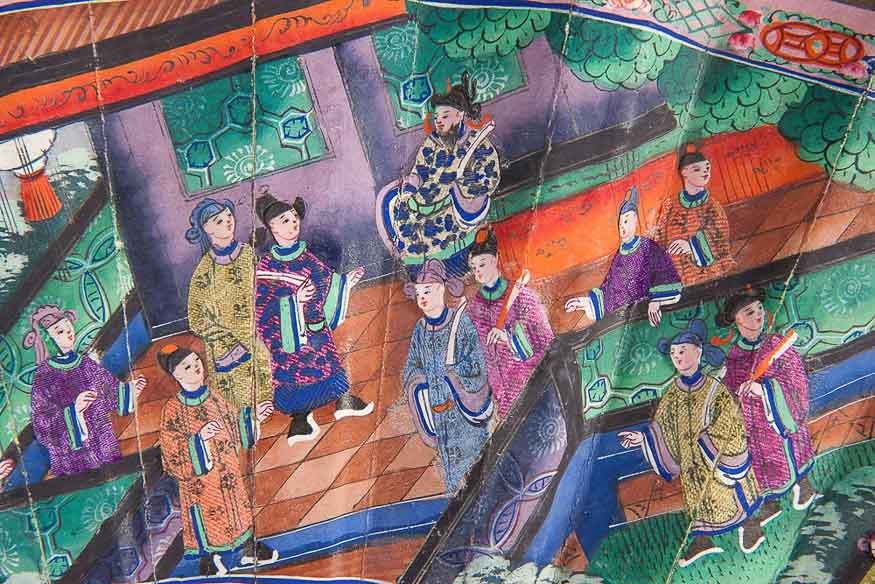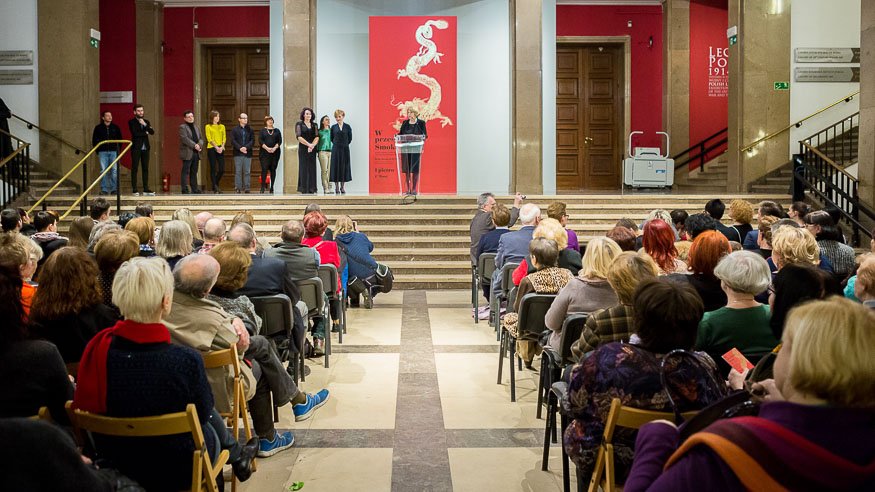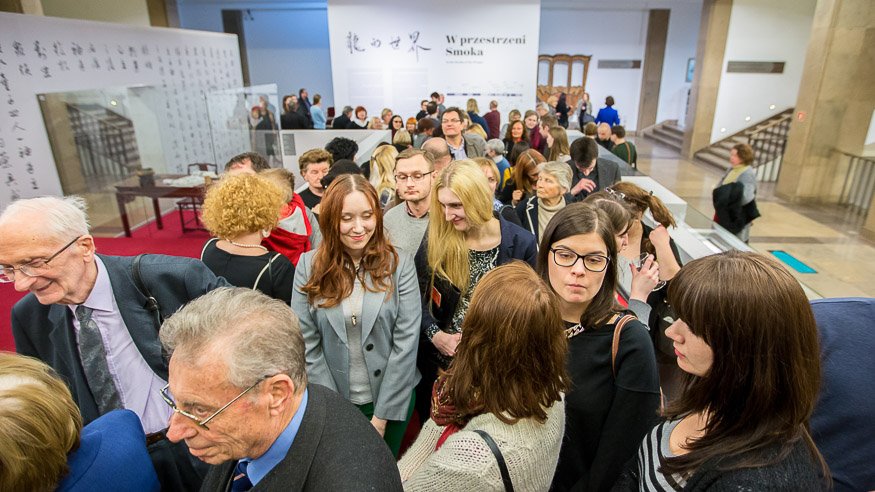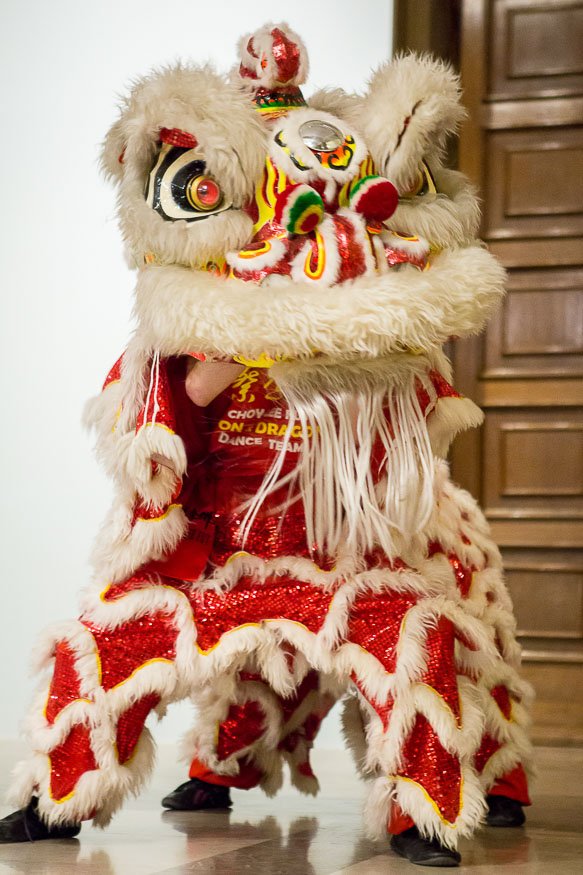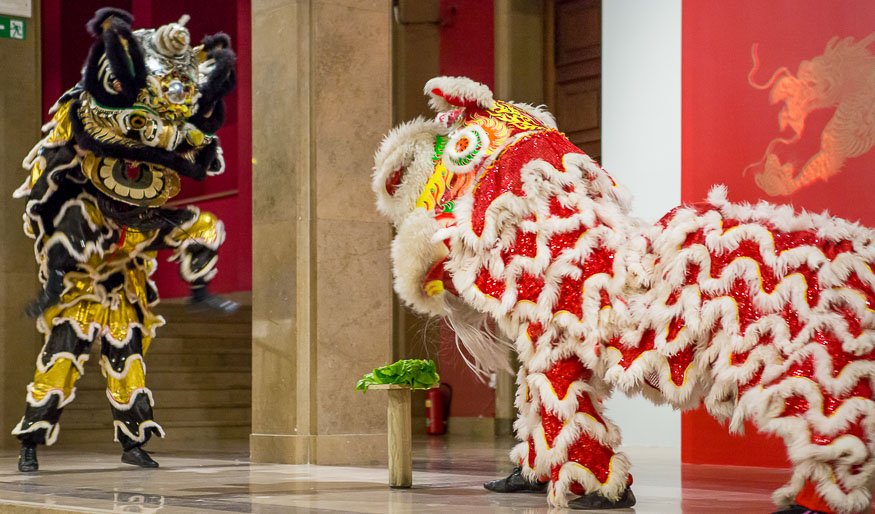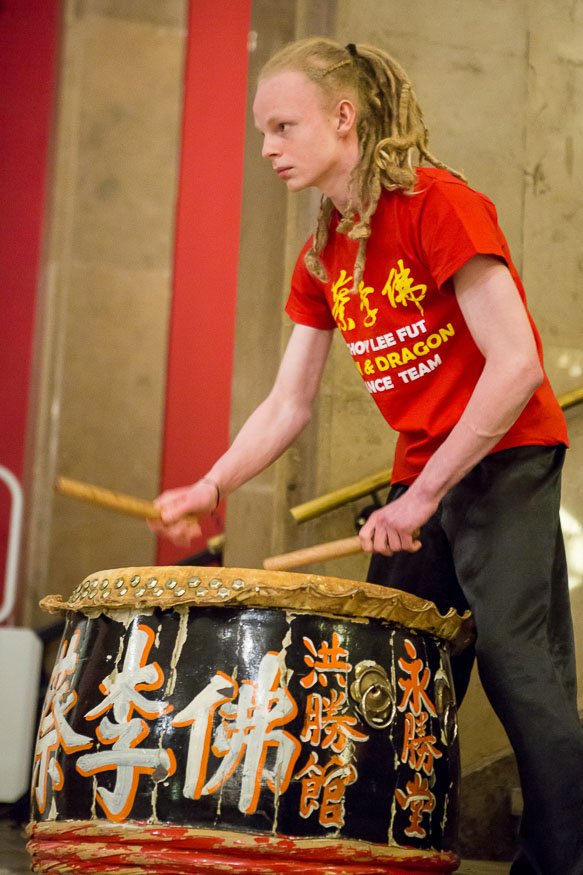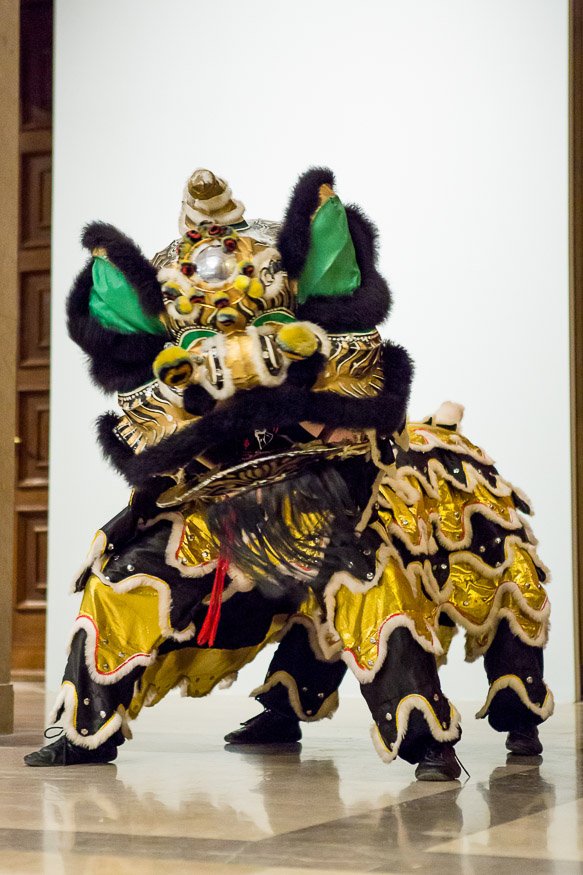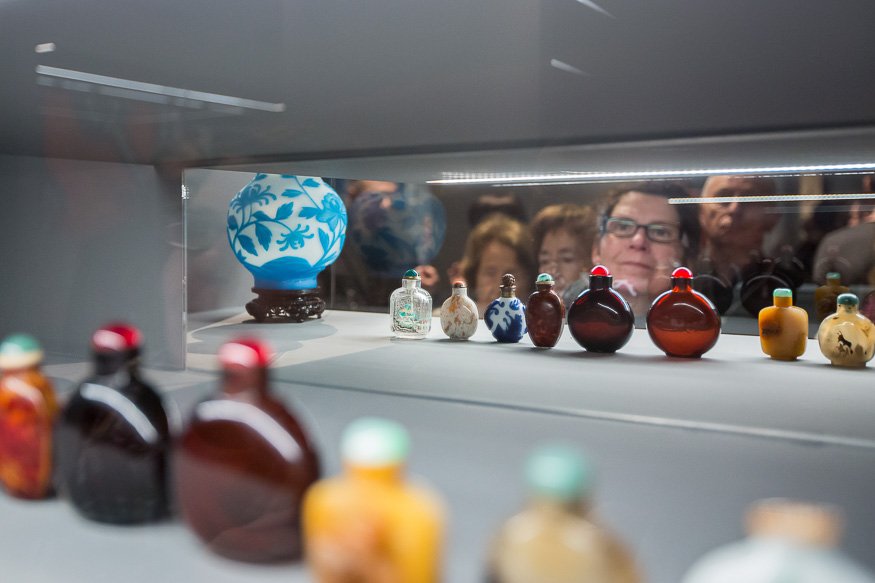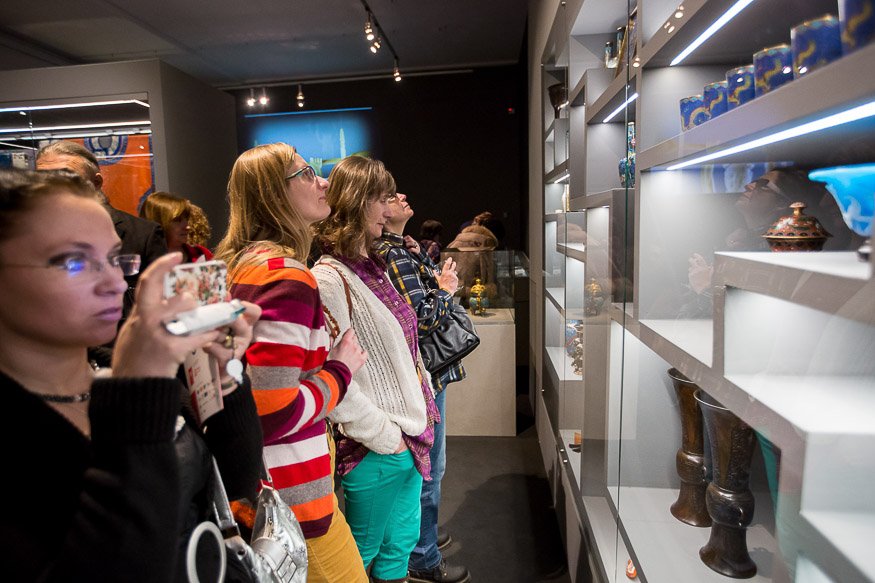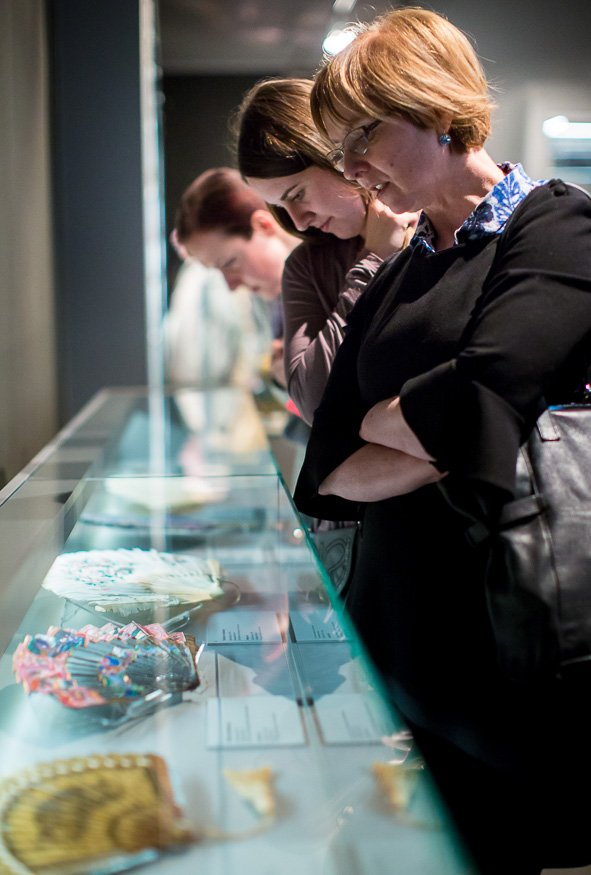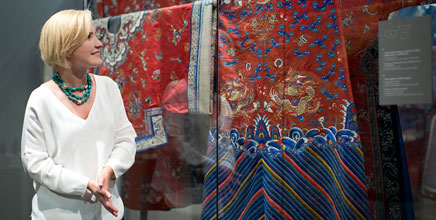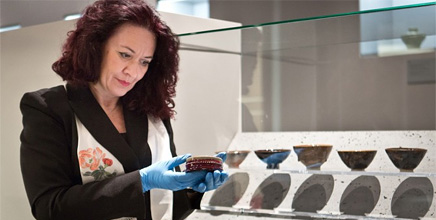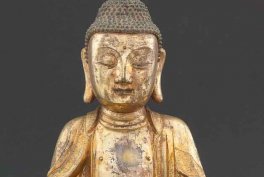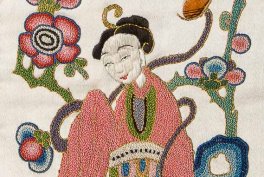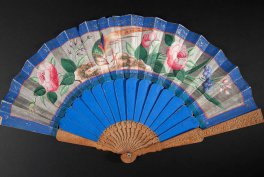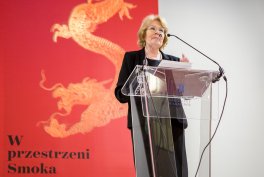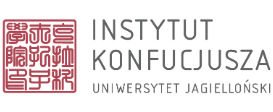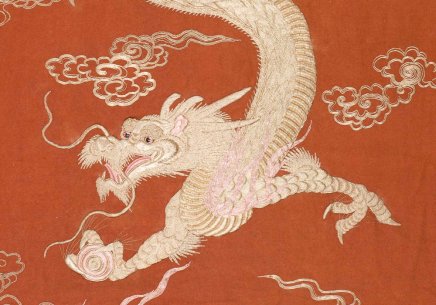
The exhibition presents 400 finest works selected from a priceless collection of Chinese art, numbering over 3,000 objects. The oldest exhibits date back to 2200 years ago, while the newest are over a hundred year old.
- The National Museum in Krakow boasts one of the best collections of Far Eastern Art in Poland. In addition to the well-known selection of objects representing Japanese art, it comprises relics of Chinese culture. Today, eighty years after the first exhibition held in the Sukiennice, we can once again extend an invitation to become acquiainted with the remarkable works of arts and crafts created by masters in ancient China. We hope that this exhibition will bring this remote and still little-known, yet very interesting culture a little closer - says Zofia Gołubiew, the Director of the National Museum.
The Cultural Revolution in China resulted in the destruction of many historic buildings and works of art, collections, libraries and antique shops. In Beijing alone, approximately five thousand out of seven thousand monuments were destroyed, which is why the collections of Chinese art preserved in various museums and cultural institutions around the world are so valuable.
The collection of Chinese art, assembled for over a hundred years through donations and purchases, encompasses all areas of arts and crafts. It contains valuable examples of paintings and prints, fascinating sculptures, exquisite ceramics, objects made of bronze, enamel, lacquer and glass, decorative tapestries, impressive clothing, accessories, furniture and musical instruments. The oldest exhibits originated in the Han Dynasty (206 BC-220 AD), whereas most of them date back to the second half of the Manchu Qing Dynasty (1644-1911).
It is the first time in its history that the National Museum in Krakow has presented such a large selection of exhibits from this collection. Visitors will be able to admire paintings, prints and Buddhist sculptures, ceramics, clothing and accessories, nephrites and jades, objects made of brass, enamel, lacquer and glass, as well as fans, pipes, snuff containers, musical instruments and toys. Many of these splendid objects will be displayed for the first time.
The exhibition creators focused on the concept of space – both in its mythical sense, controlled by the title Dragon as well as in its cultural, literary, aesthetic and philosophical aspects. In Chinese culture, the Dragon – as the king of heaven and water, the first of the "360 animals with scales", the fifth animal of the Chinese zodiac, a creature laden with symbols - is mostly good-natured. It symbolizes the male power of nature as well as the son of heaven and the emperor. In China, it is associated with the idea of good and positive forces fuelling changes, which in a natural way refers to the idea of rebirth and directly – to life.
Exhibition curators: Beata Pacana, Beata Romanowicz
Coordinator: Grażyna Kulawik
Design: Teren Prywatny – Anna Grzywa, Marcin Przybyłko and Sławomir Pankiewicz
MNK The Main Building
al. 3 Maja 1 temporary exhibition hall, 1st floor- Monday: closed
- Tuesday - Sunday: 10.00-18.00
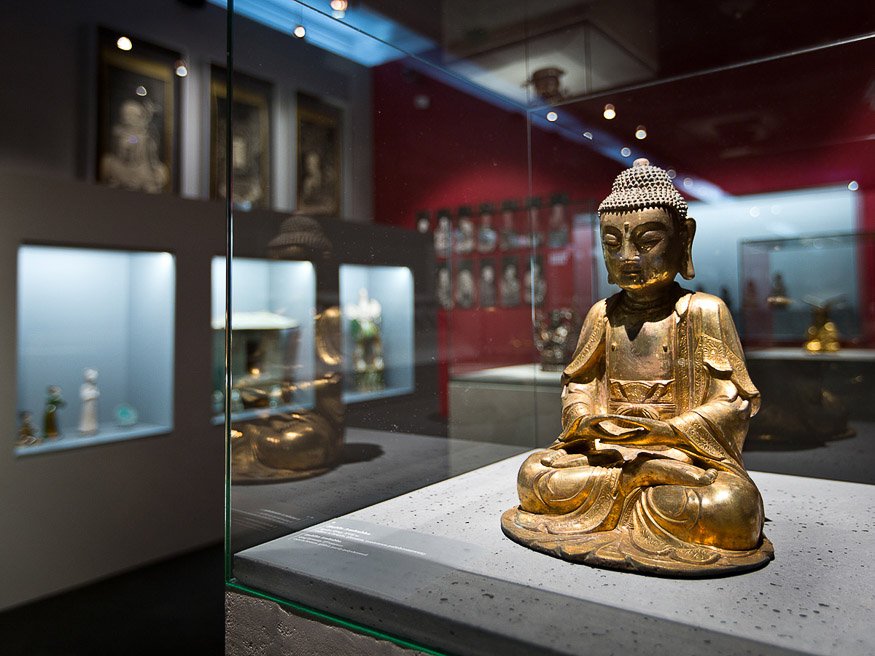
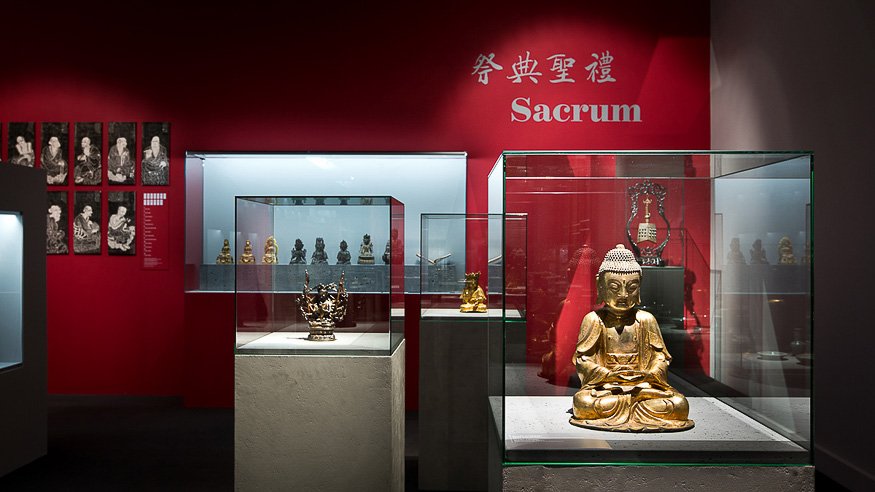
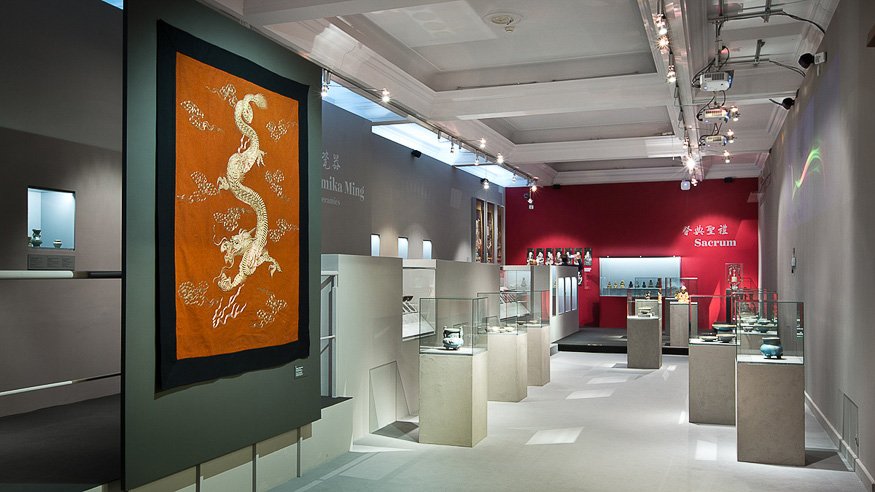

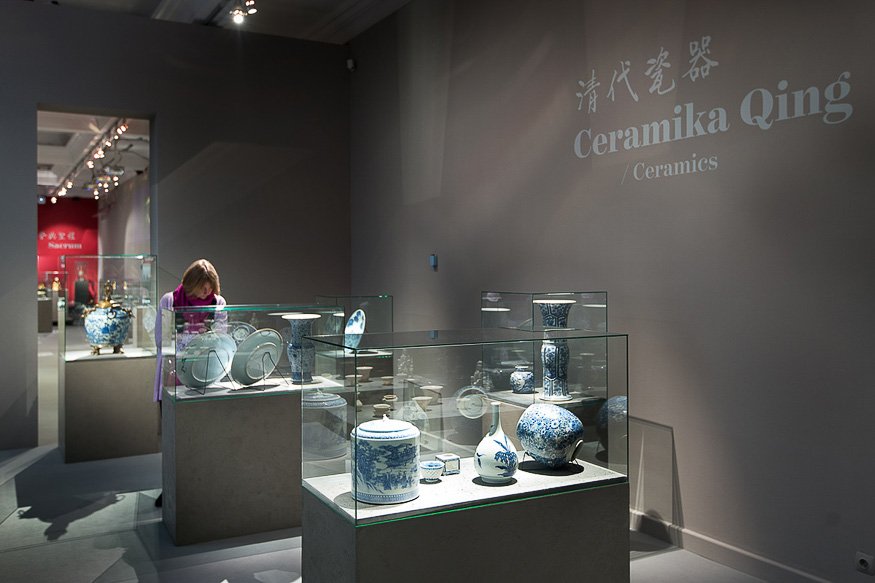
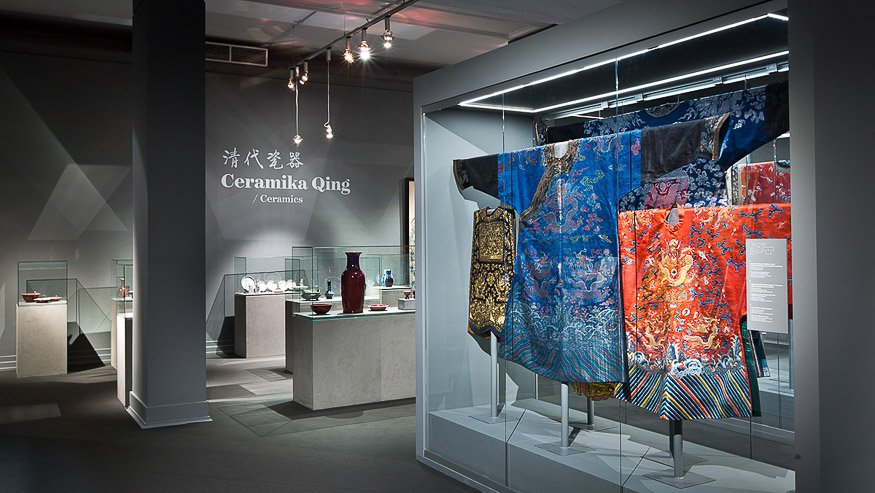
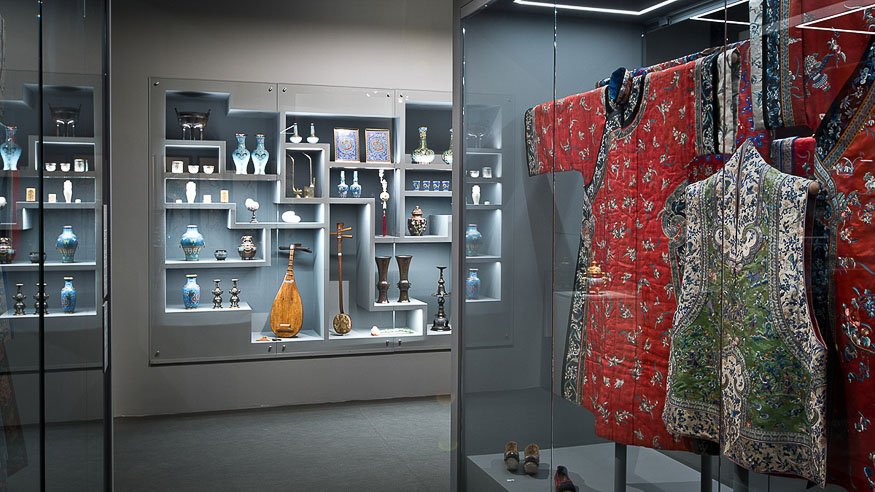
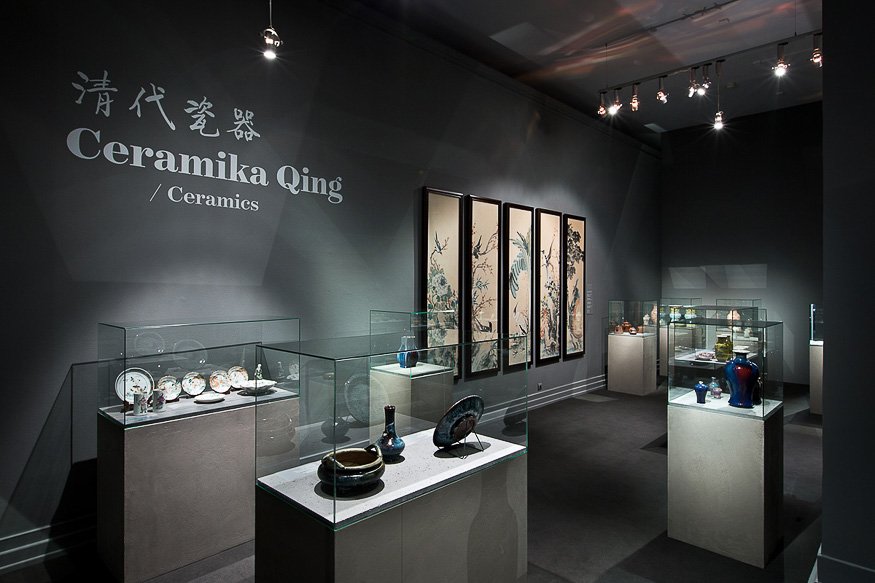



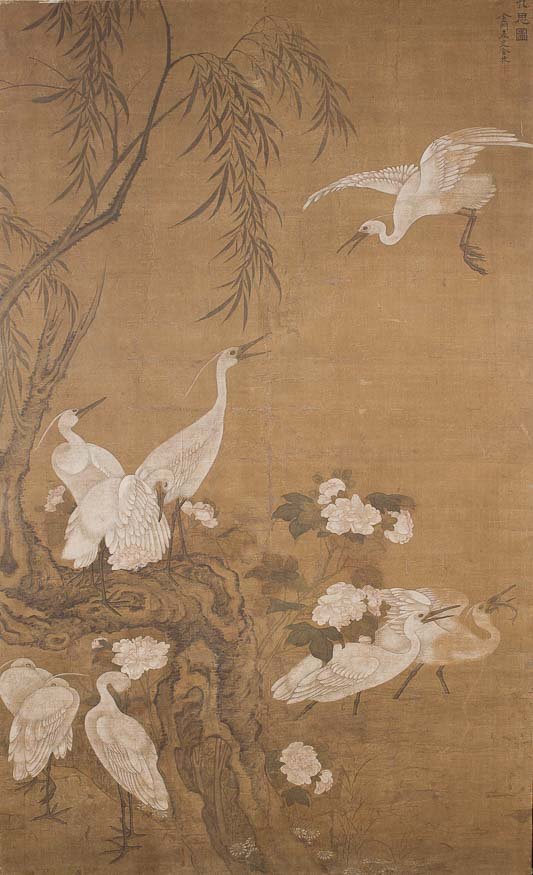
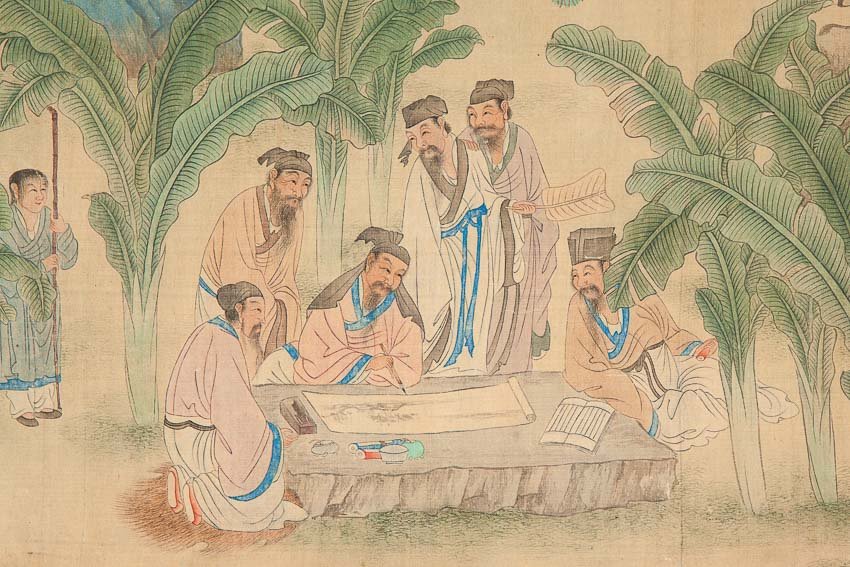

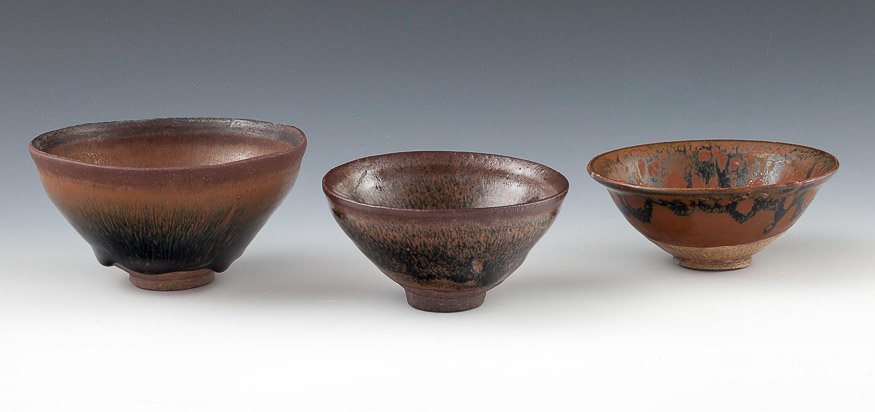
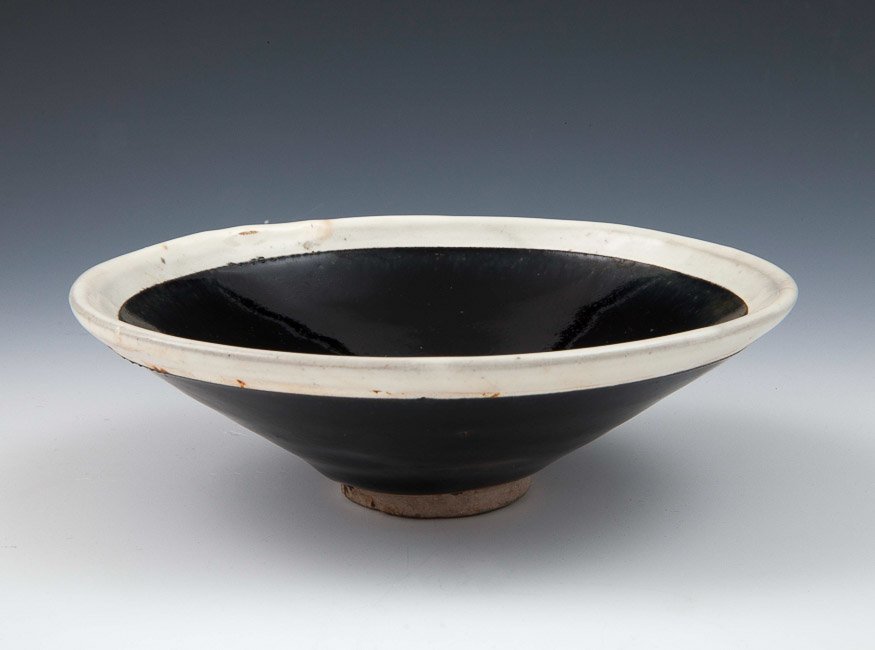
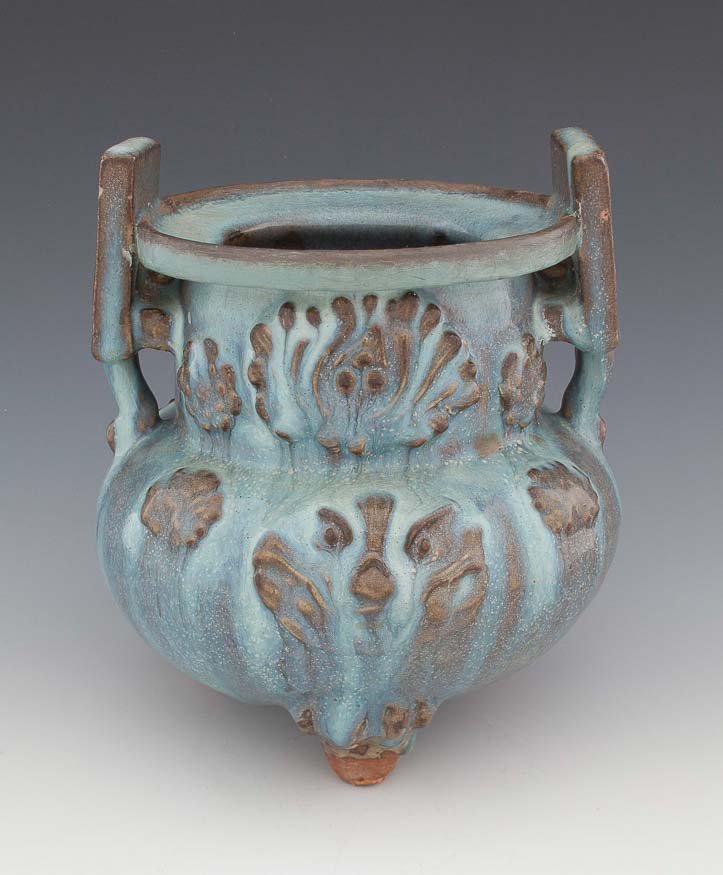
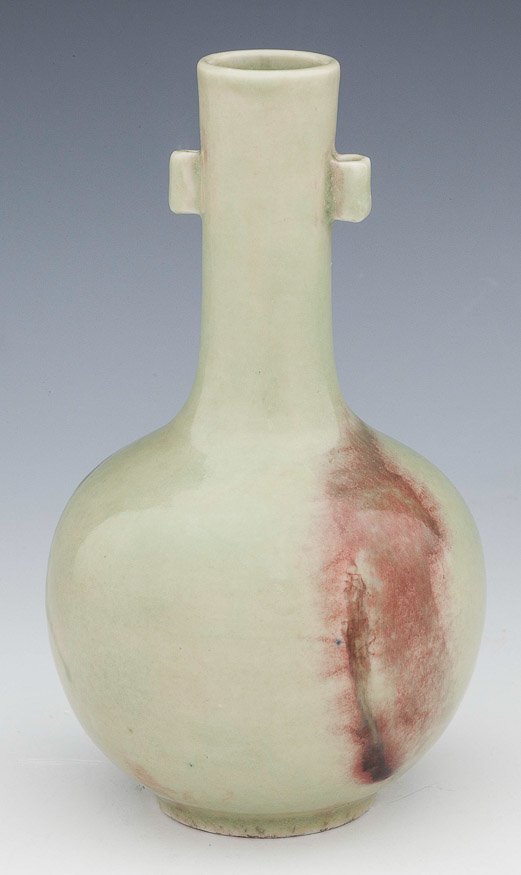
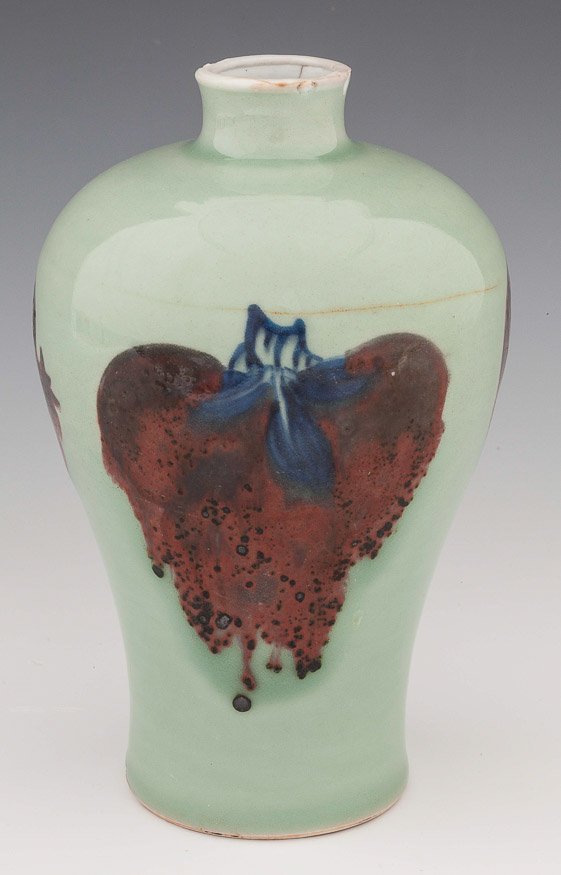
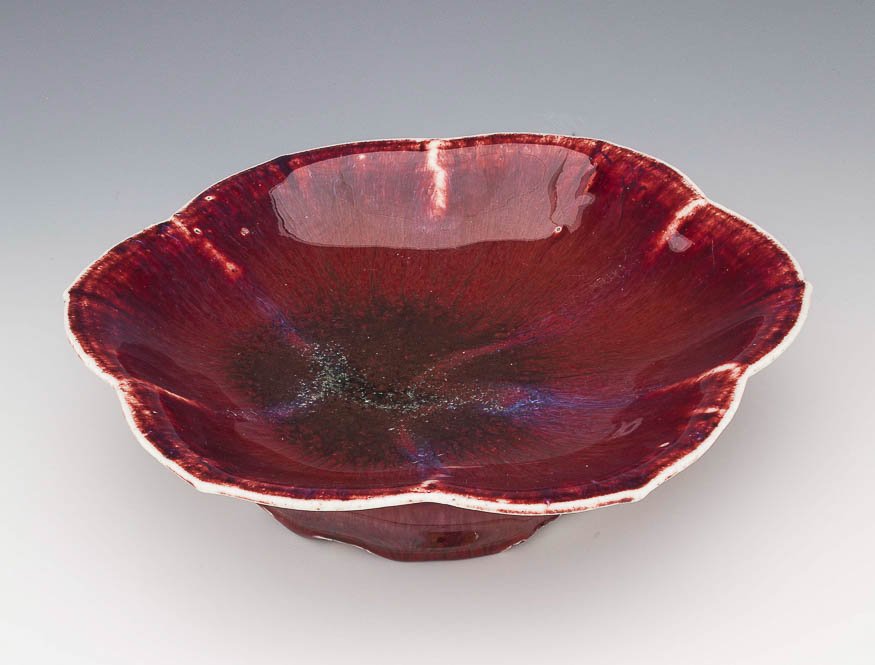
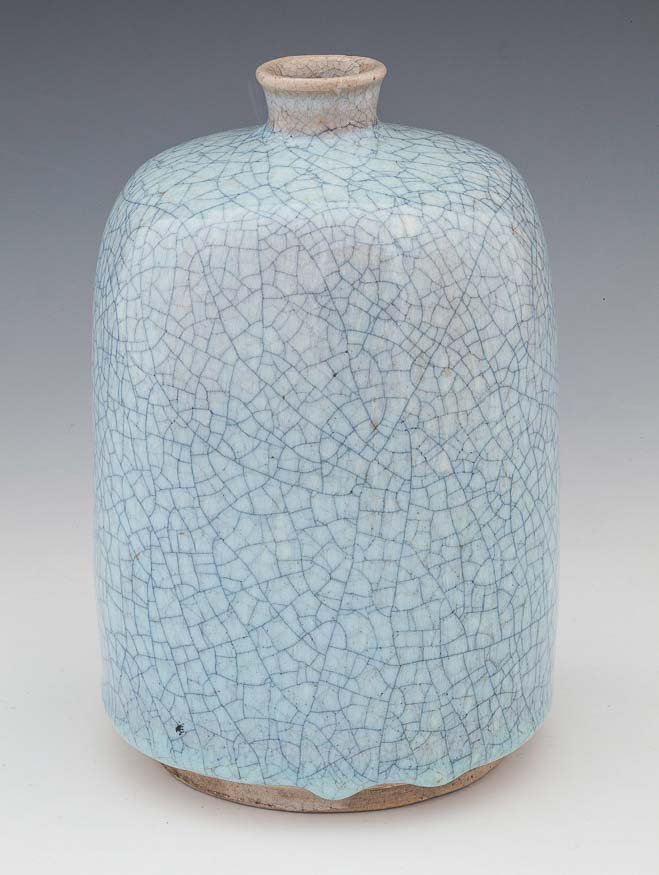
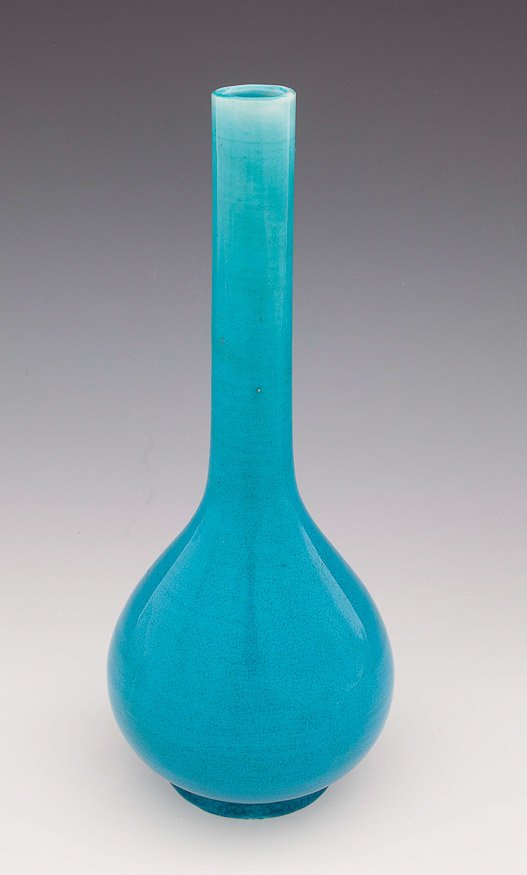
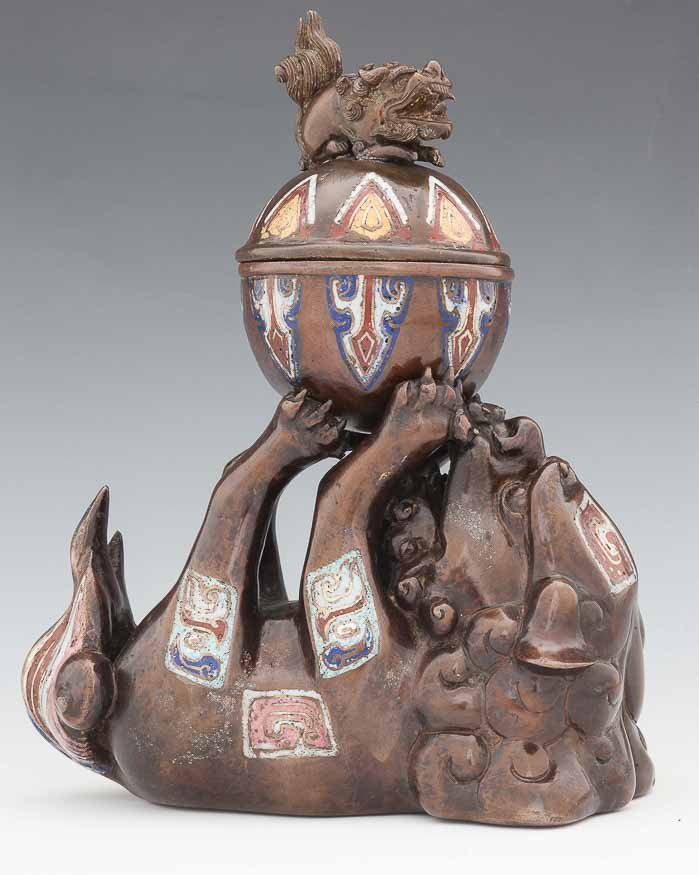

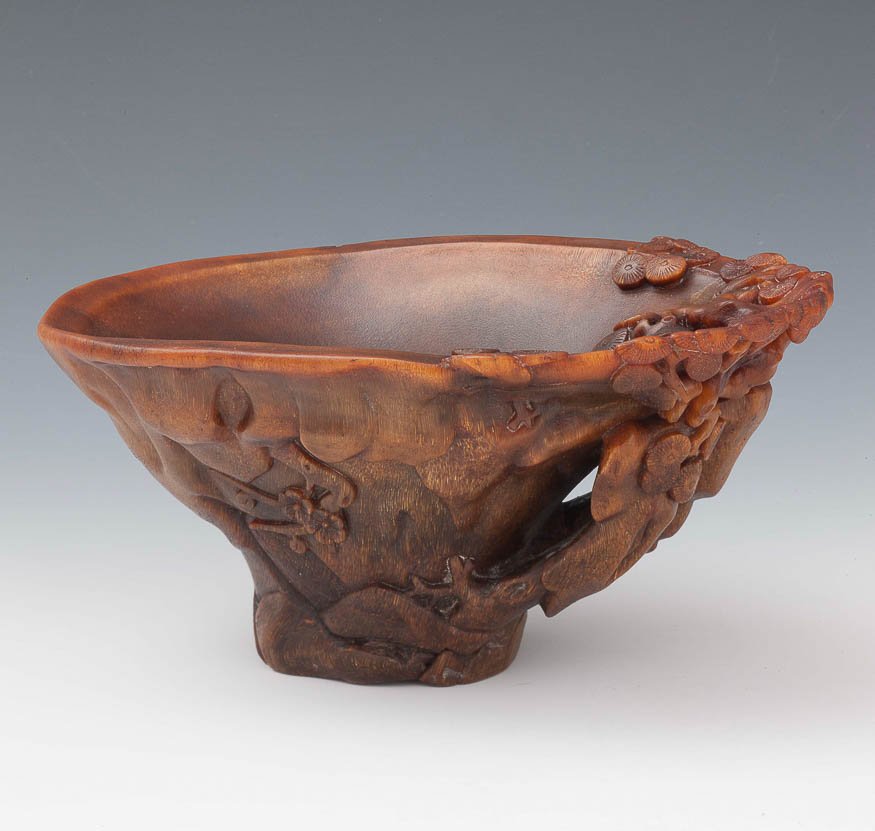
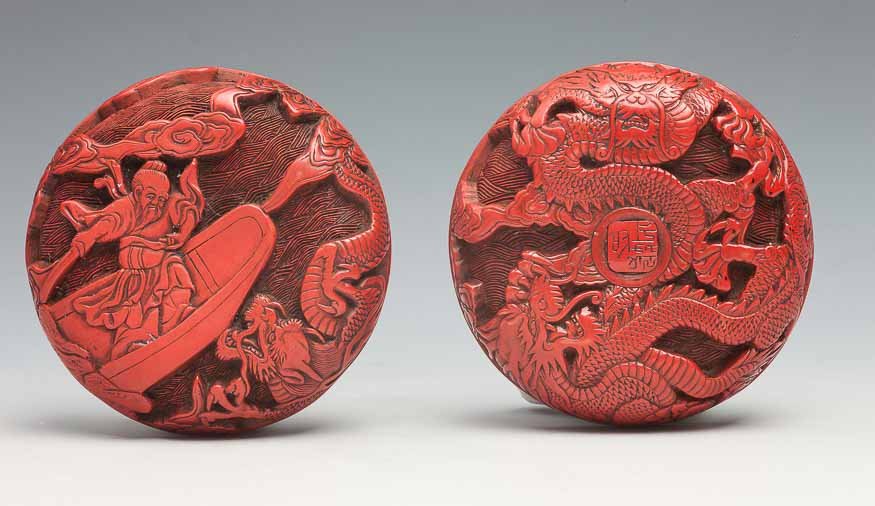

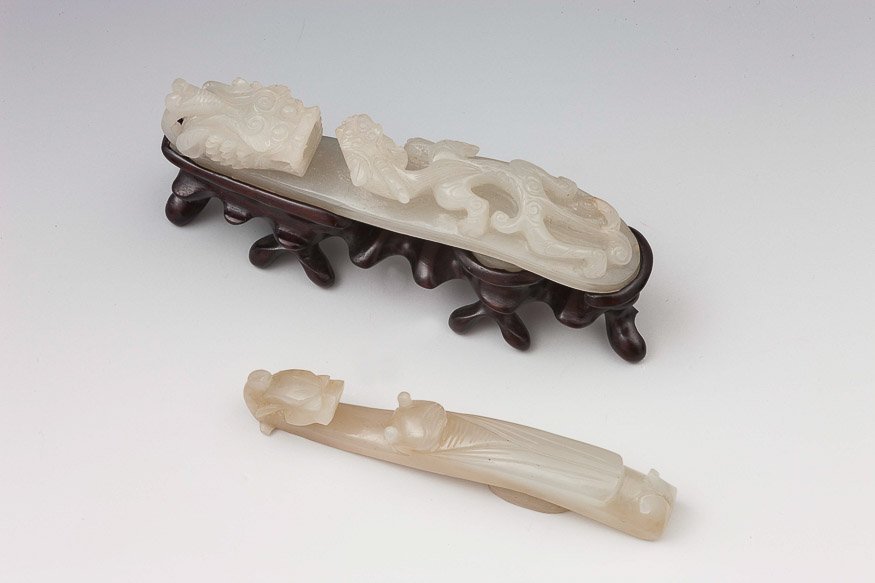
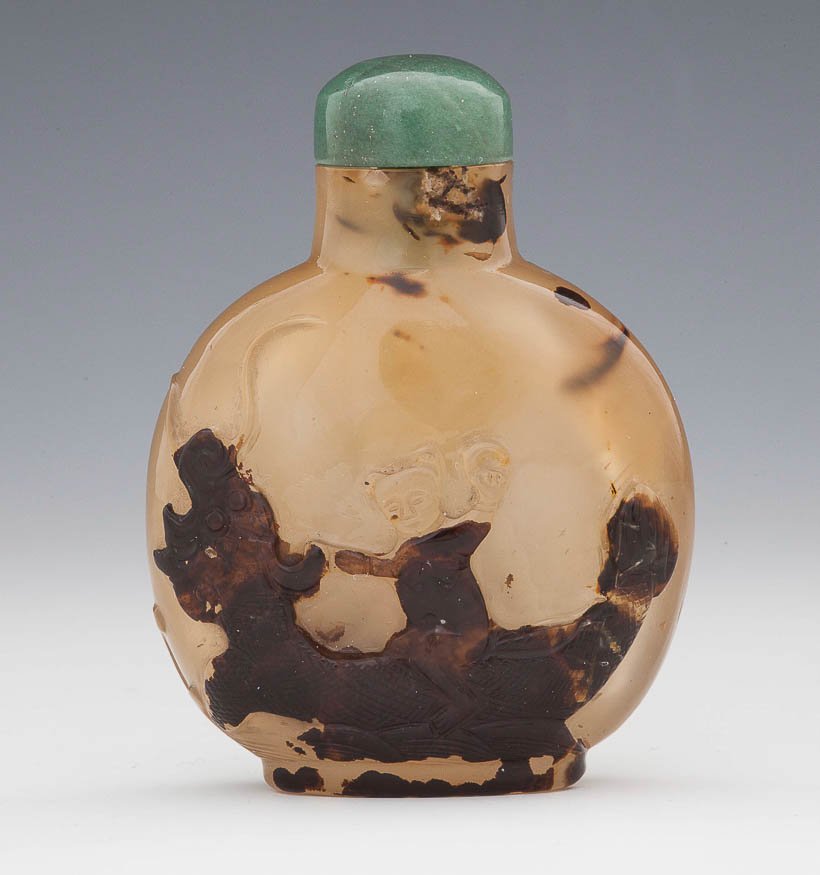
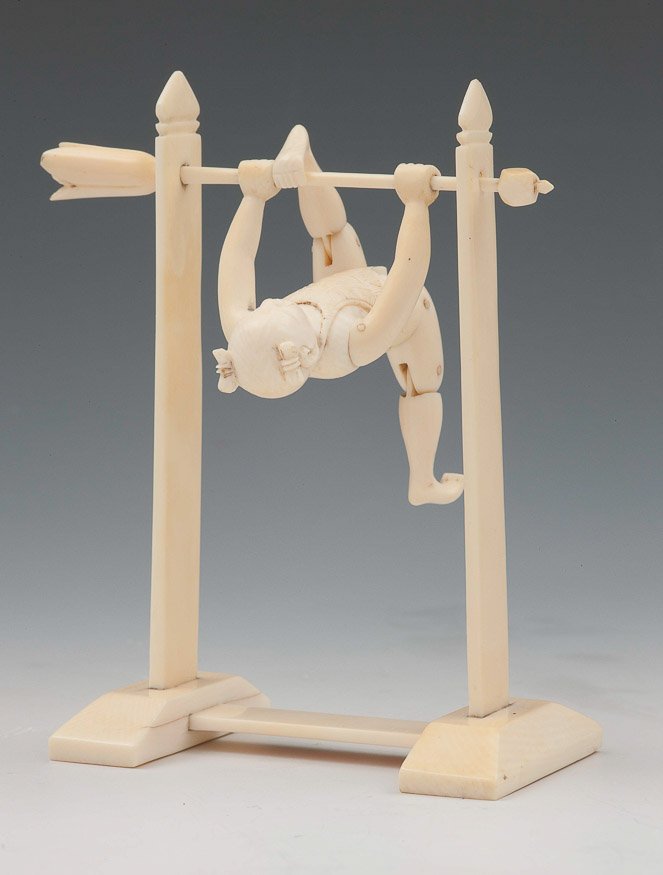
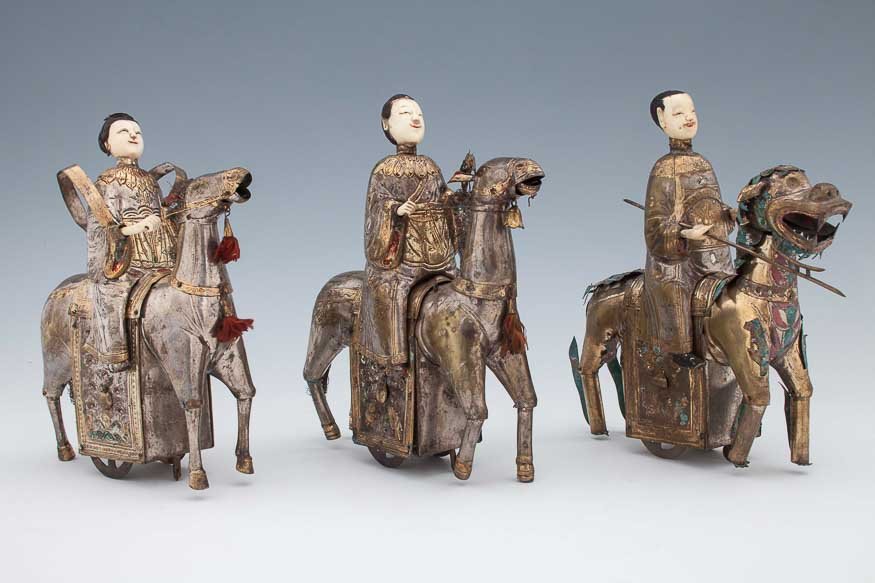
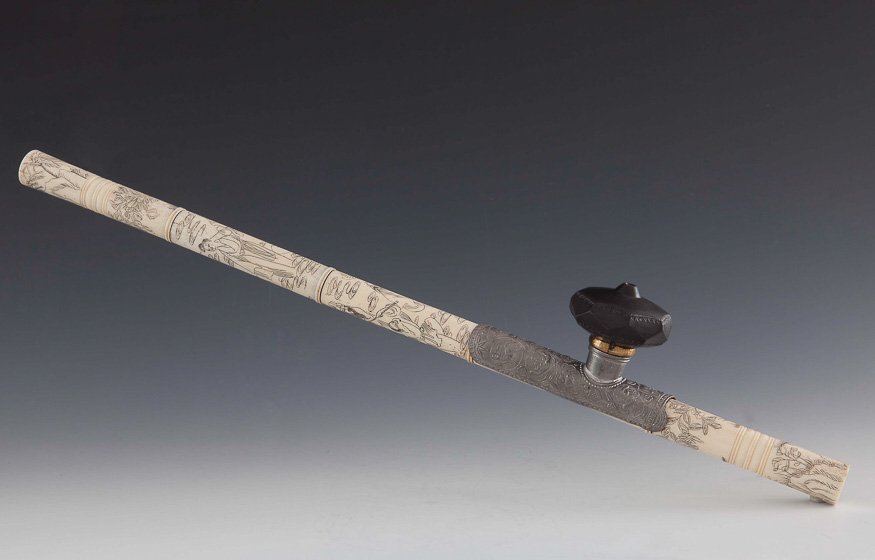
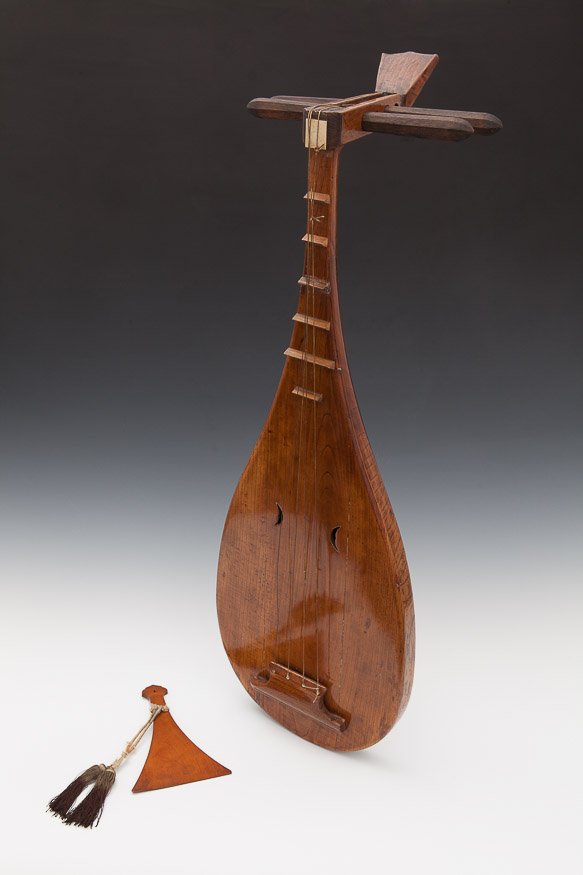
Qing Dynasty, 19th century, silk, golden thread, brocaded
This men's garment, called a dragon robe, constitutes part of a traditional semi-formal ji fu outfit in the Manchu style. Wearing such clothing befitted the Emperor, his immediate family and the representatives of the clerical class. The members of the imperial administration, called mandarins by the Europeans, wore robes in dark blue colour.
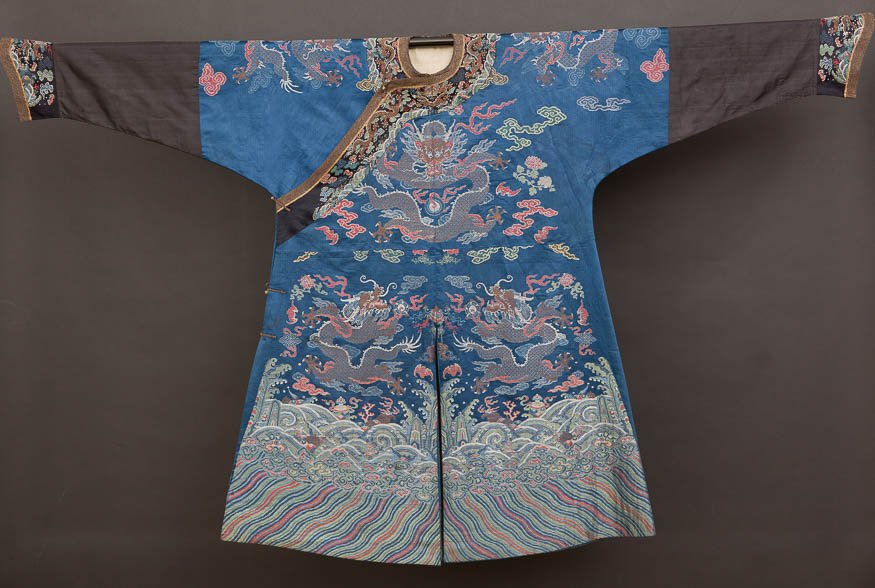

The longpao from the collection of the National Museum in Krakow belonged to a prominent collector - Feliks „Manggha” Jasieński, who was portrayed in this particular garment by Leon Wyczółkowski.

Qing Dynasty, 19th-20th century.
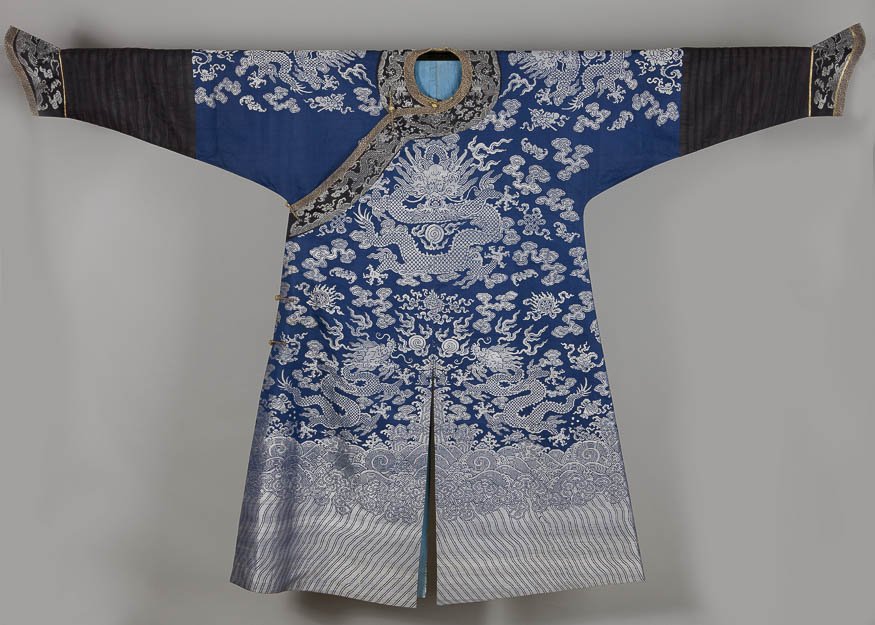
Qing Dynasty, second half of the 19th century.
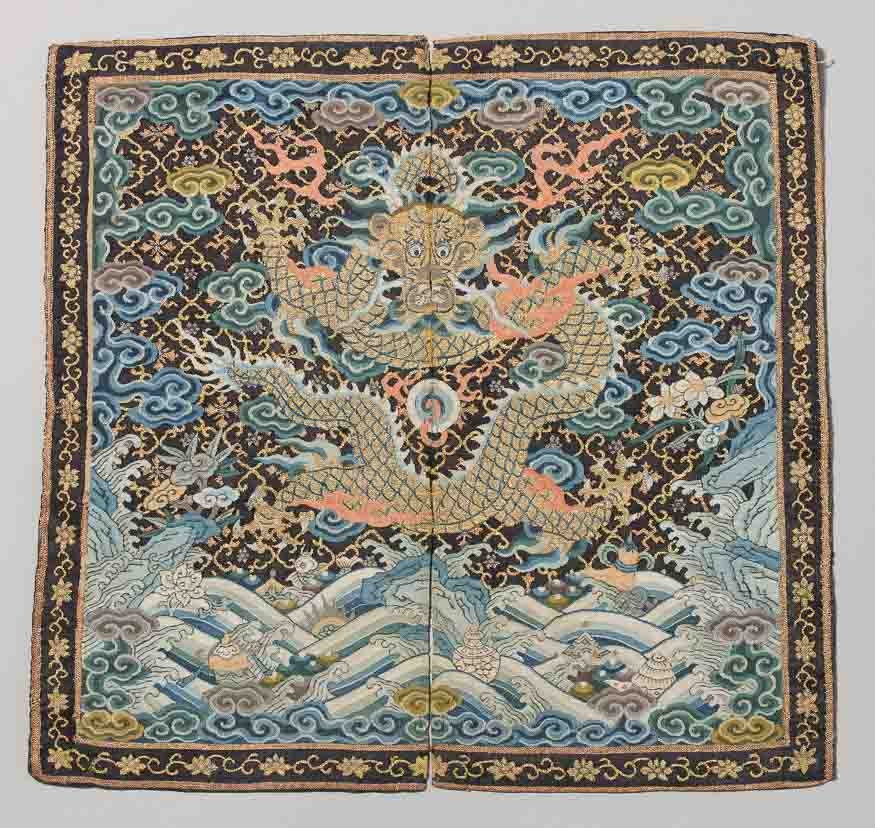
Qing Dynasty, second half of the 19th century.
Badges with an image of a crane were attributed to the officials who, having passed multi-stage exams, achieved the highest rank. The extremely valuable background of the badge deserves a particular attention. Its green surface, with a metallic shine, was woven using peacock feathers.
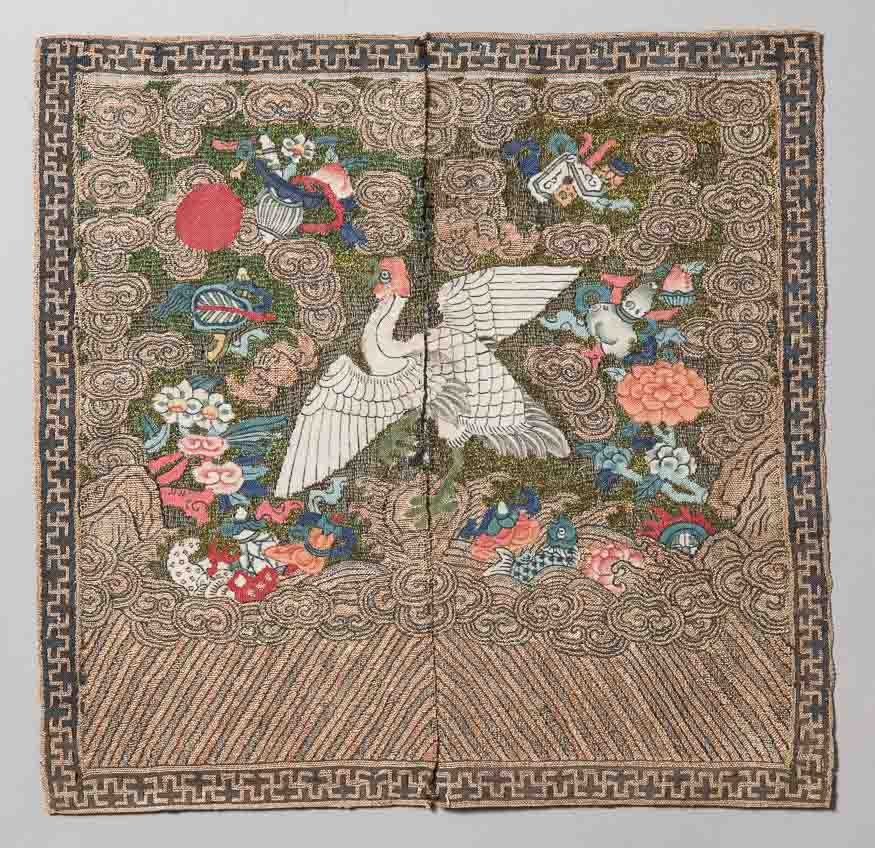
Qing Dynasty, first half of the 19th century, silk, golden thread, embroidery.
This valuable badge, belonging to a fourth-ranking official and dating back to the late Manchu Dynasty, was decorated with numerous symbols of luck and longevity. It was made applying a couching stitch technique using a metal thread with a silk core. This technique, dating back to ancient times, involved forming a pattern of connected gold cords, fastened to the fabric with a silk yarn.
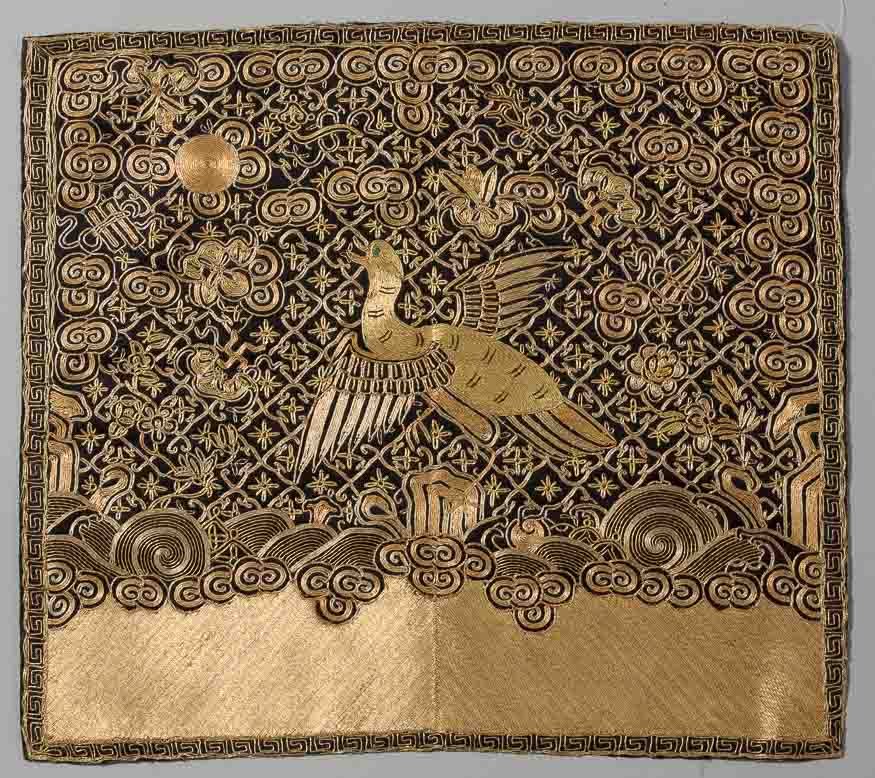
Qing Dynasty, 19th-20th century.
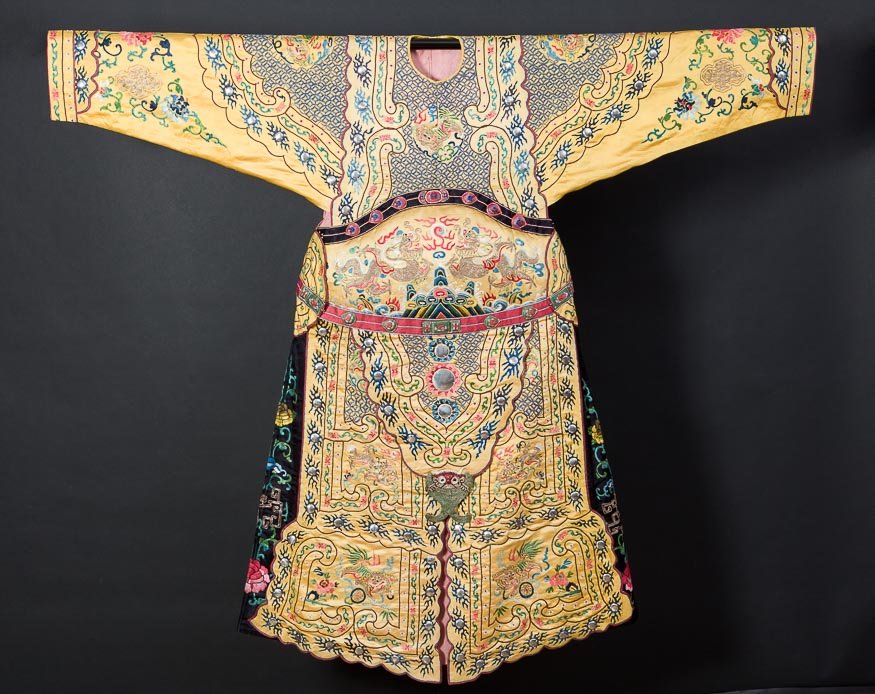
Qing Dynasty, second half of the 19th century.
Worn on the occasion of weddings and official ceremonies, this particular type of outfit could only be worn by a wife of a Chinese official whose rank was appropriately high. Its red colour symbolizes prosperity, similarly to numerous bats and Taoist symbols.
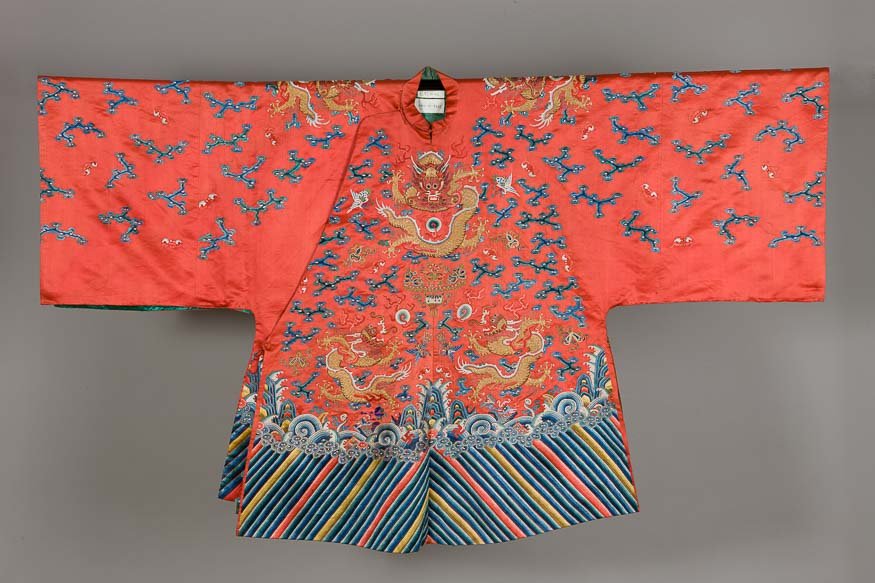
Qing Dynasty, 19th century.
The main motif of the robe consists of eight medallions with court scenes embroidered in the landscape. Among the depictions, one can spot people playing the lute (sanxian), fishing, running with a kite, writing poems. Note the decorative yun jian collar in the form of stylized clouds.

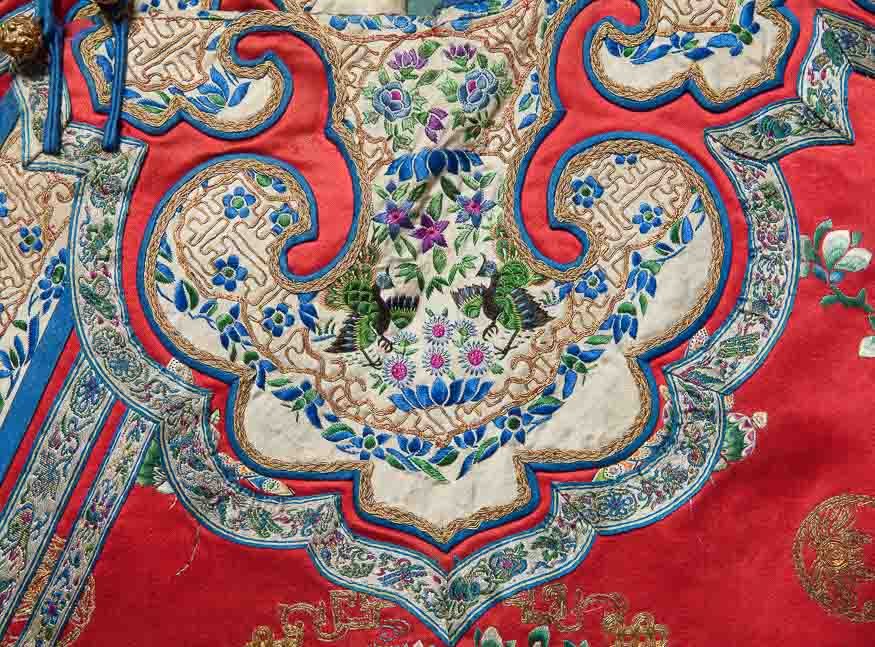
Qing Dynasty, 19th century.

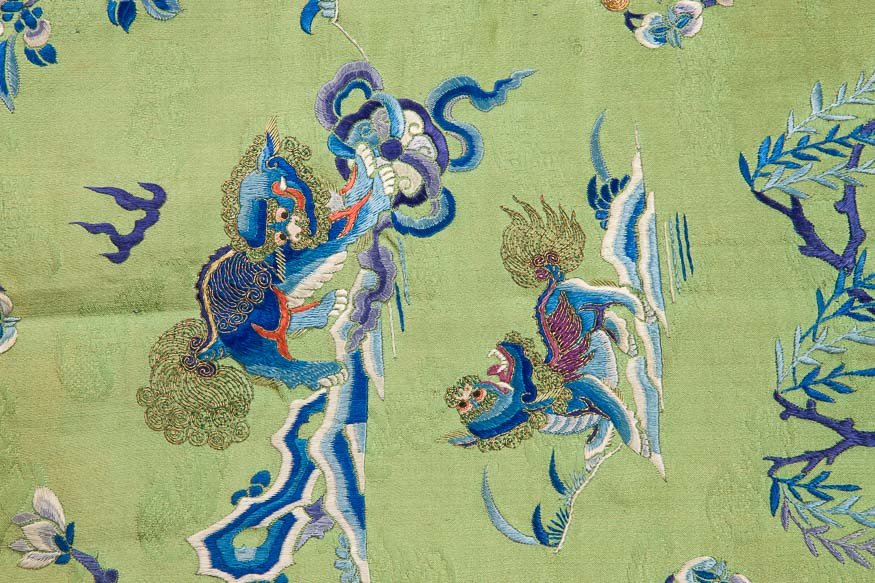
Qing Dynasty, second half of the 19th century.
This casual woman's robe is adorned with the motif of the Four Nobles - plants symbolizing the four seasons. The two-coloured – blue and pink – damask contains depictions of plum blossom branches which refer to the spring, orchid flowers which symbolize the summer, chrysanthemum - the flower of the autumn and a bamboo representing winter. The peony, which appears in this composition, is regarded in China as the queen of flowers and refers to feminine beauty.
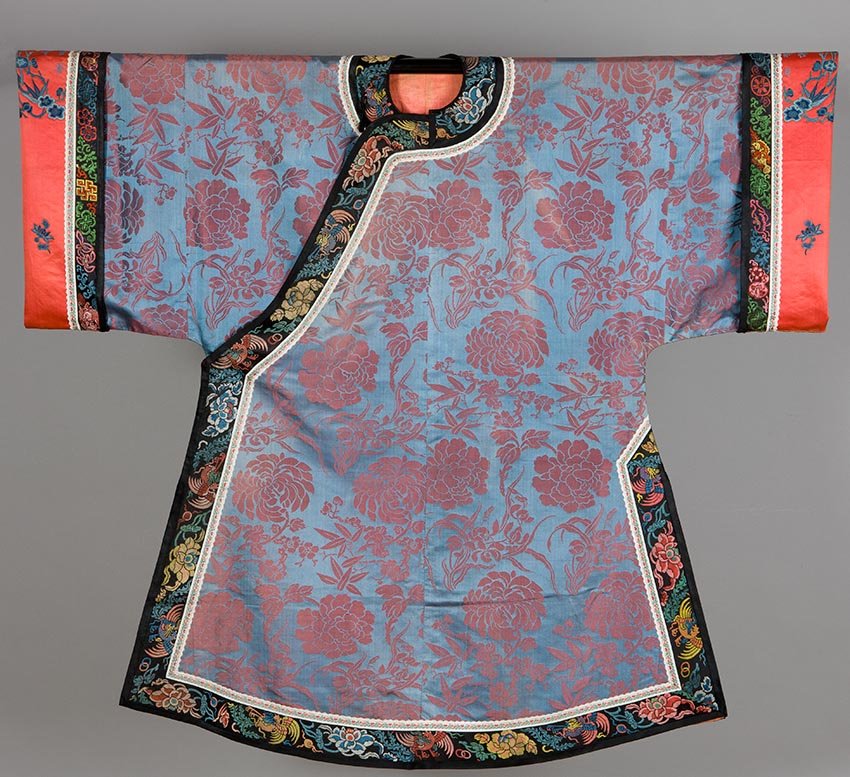

Qing Dynasty, first half of the 19th century, silk, gilded copper button knots, embroidery, applique.
The main decorative motifs of this robe are orchid flowers and butterflies. The Chinese valued the orchid flowers for their subtle fragrance and elegance. They associated them with concepts such as love, beauty and fertility as well as with qualities of virtue and moral excellence. The motif of a hundred butterflies, symbolizing a Hundred Blessings, was a favourite robe pattern of the last Empress - Cixi (1834-1908).
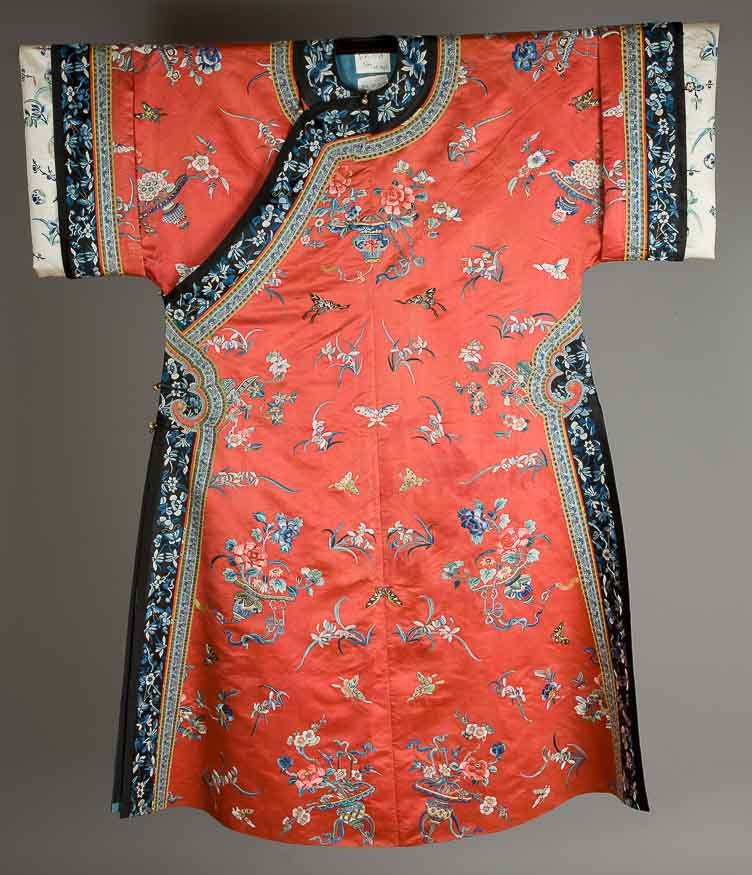
Qing Dynasty, 19th-20th century.
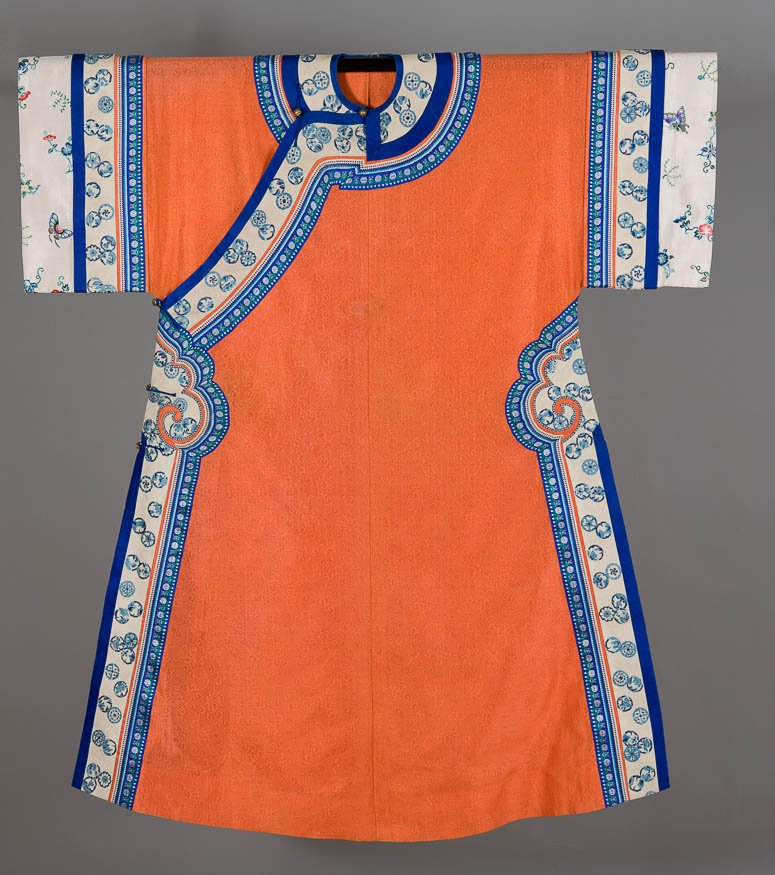
Qing Dynasty, early 20th century.
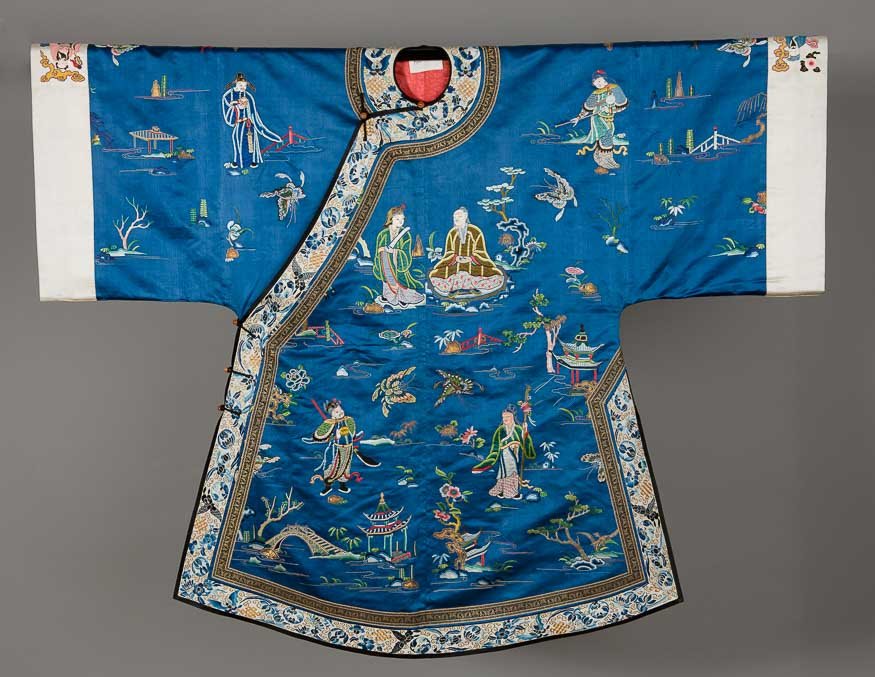
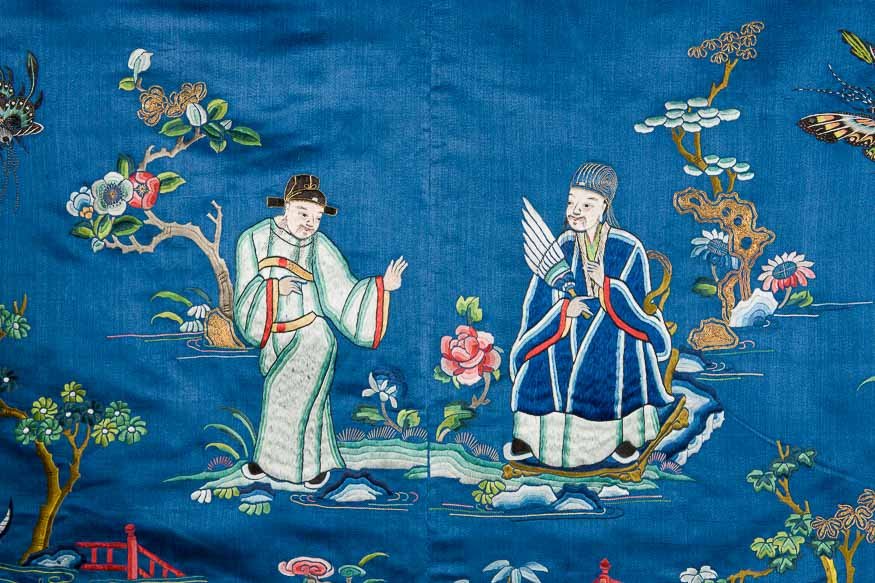
Qing Dynasty, 19th century.
The collection of the National Museum in Krakow features a skirt made of silk gauze woven in a pattern depicting swastikas and peonies. It is decorated with black trimmings and embroidery in the shades of blue (sanlan) with orchid, butterfly and bat motifs. The front and rear parts of the skirt present an embroidered water landscape with a pair of Mandarin ducks among lotus flowers, peonies and pomegranates.
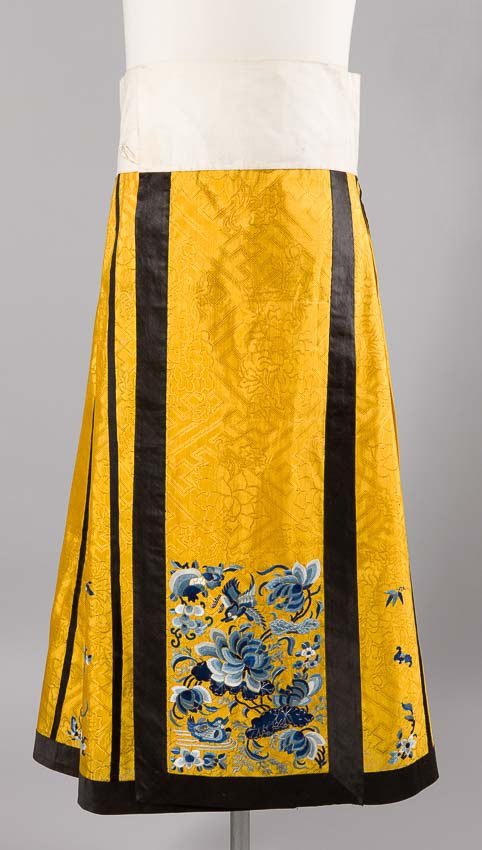
Qing Dynasty, 19th century.
The collection of the National Museum in Krakow features a skirt made of silk gauze woven in a pattern depicting swastikas and peonies. It is decorated with black trimmings and embroidery in the shades of blue (sanlan) with orchid, butterfly and bat motifs. The front and rear parts of the skirt present an embroidered water landscape with a pair of Mandarin ducks among lotus flowers, peonies and pomegranates.
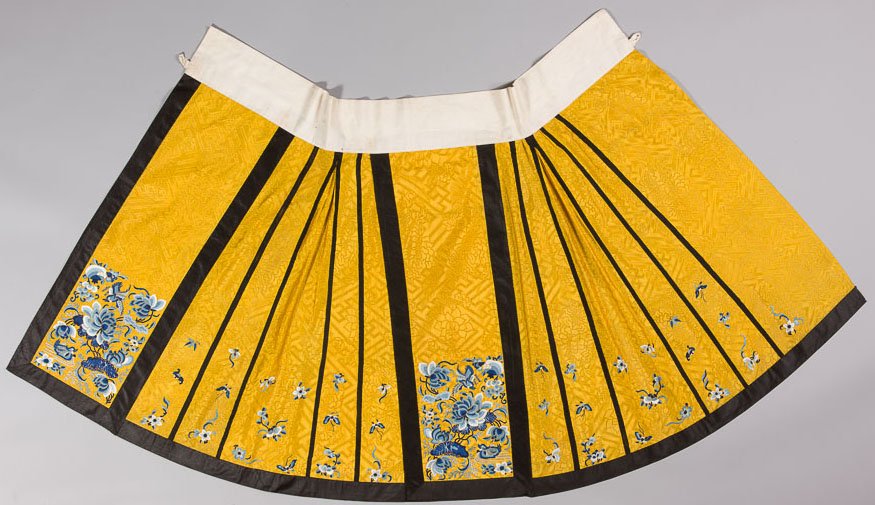
Qing Dynasty, 19th-20th century.
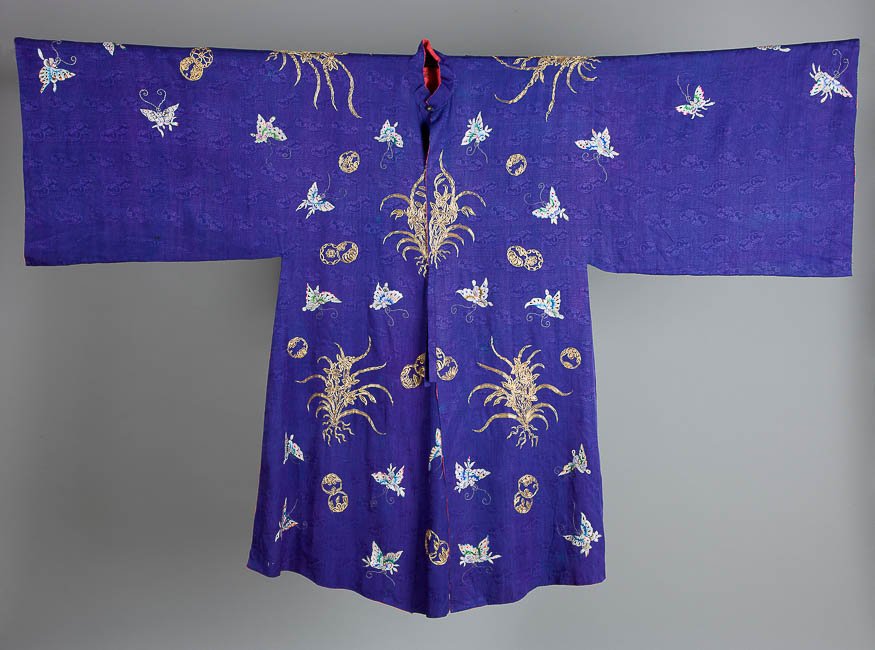

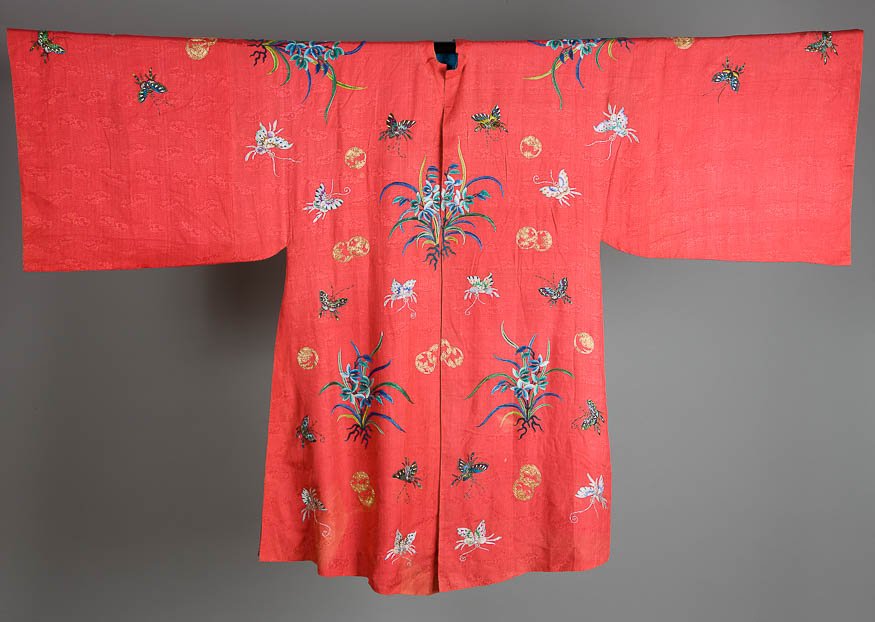
Qing Dynasty, 19th century, silk, golden thread, embroidery.
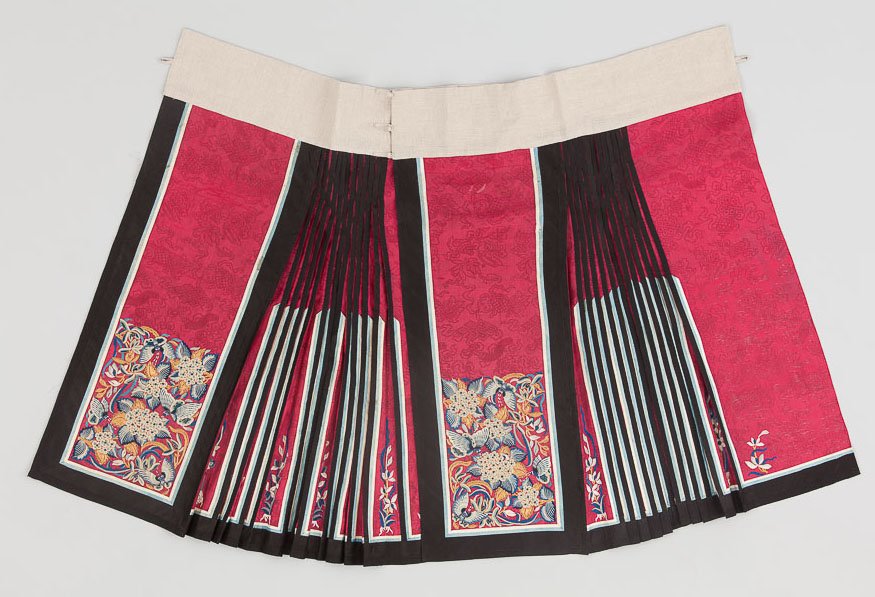
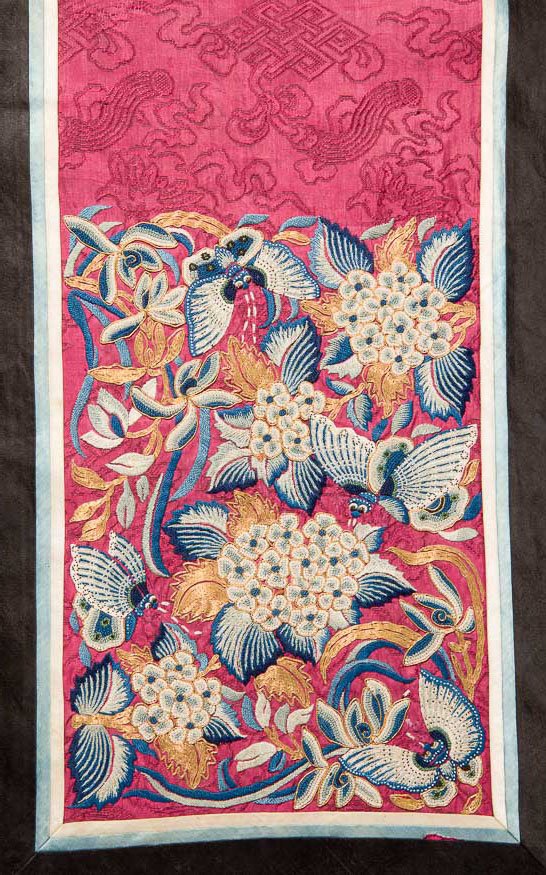
Qing Dynasty, 19th century.
Silk, cotton, golden thread, leather, glass, embroidery, applique.
In China, children's shoes were decorated with auspicious images of tigers or lions (shizi), which were meant to protect them against evil demons. The eyes and ears were distinctly highlighted as those were the parts of the body through which the animals recognized dangerous powers. Similar motifs were also used to embellish headgear and entire outfits for children, particularly around the New Year or other major holidays.

Qing Dynasty, 19th century.
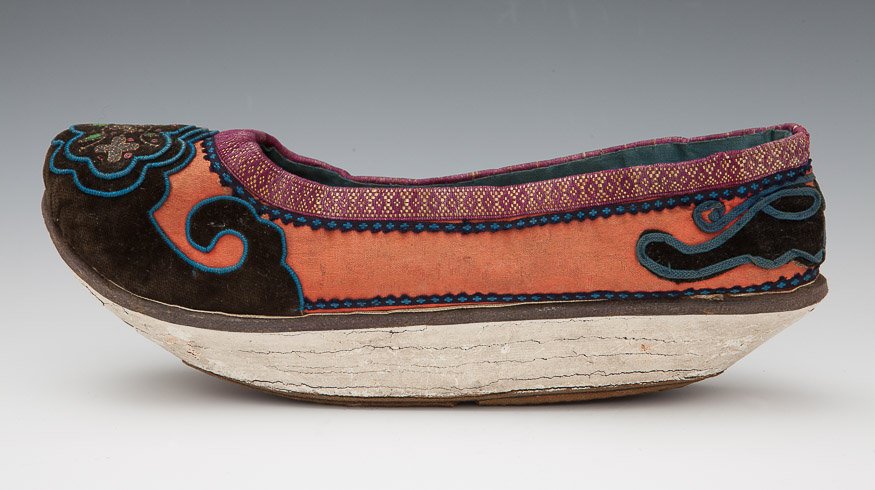
Qing Dynasty, late 19th century.
Silk, kesi technique.
The image of a peacock with a peach branch and Taoist emblems are popular symbols of longevity and prosperity. Robes adorned with such motifs were worn on the occasion of birthdays.
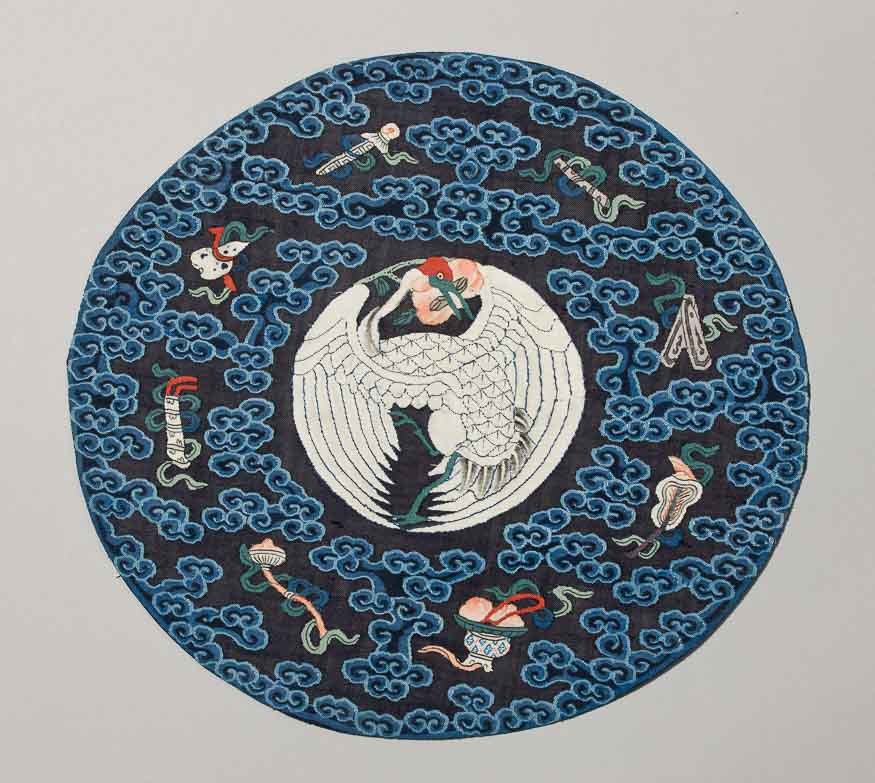
Qing Dynasty, early 20th century.
Silk, golden thread, sequins, embroidery.
The cuffs of woman's robe are decorated with the image of He Xiangu – one of the Eight Immortals (baxian). Her figure was embroidered with knot stitch.
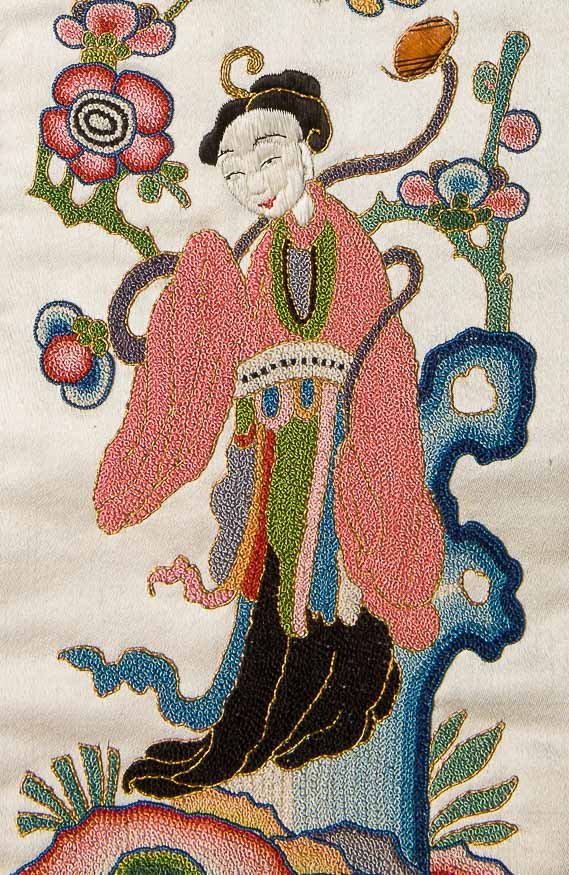
Qing Dynasty, 19th century.
Silk, embroidery.
Embroidery in blue hues (sanlan) with a popular motif depicting flowers and fruit (hua guo). As ornaments on ladies' robes, they symbolise numerous virtues: lotus flower – purity and modesty, peony – beauty, chrysanthemum – longevity, plum – innocence. Melon, on the other hand, is a symbol of unity and strength of the family.
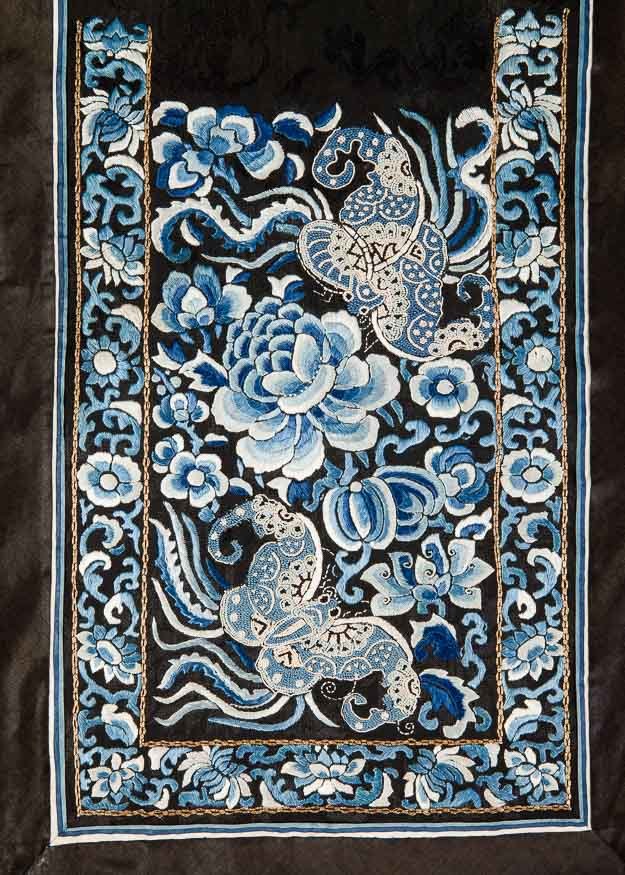
Qing Dynasty, 19th century.
Silk, embroidery.
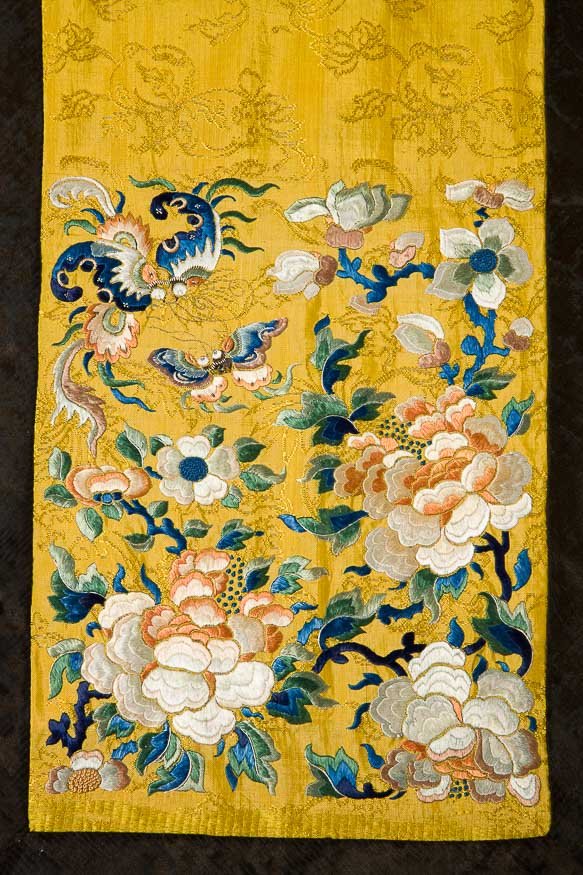
Qing Dynasty, 19th century.
Silk, embroidery.
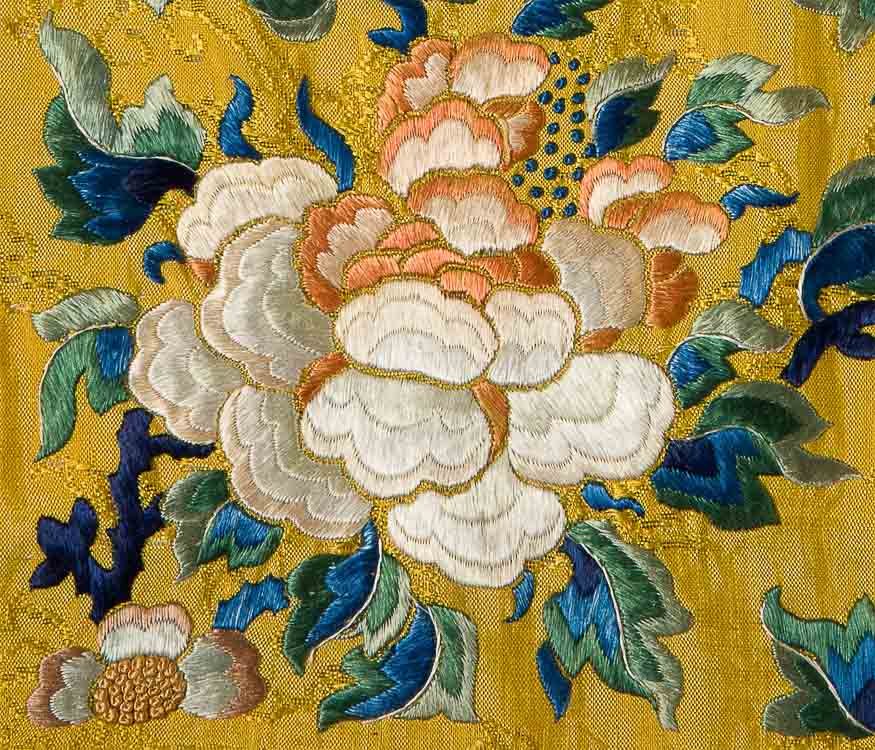
Qing Dynasty, second half of the 19th century.
Silk, golden thread, embroidery.
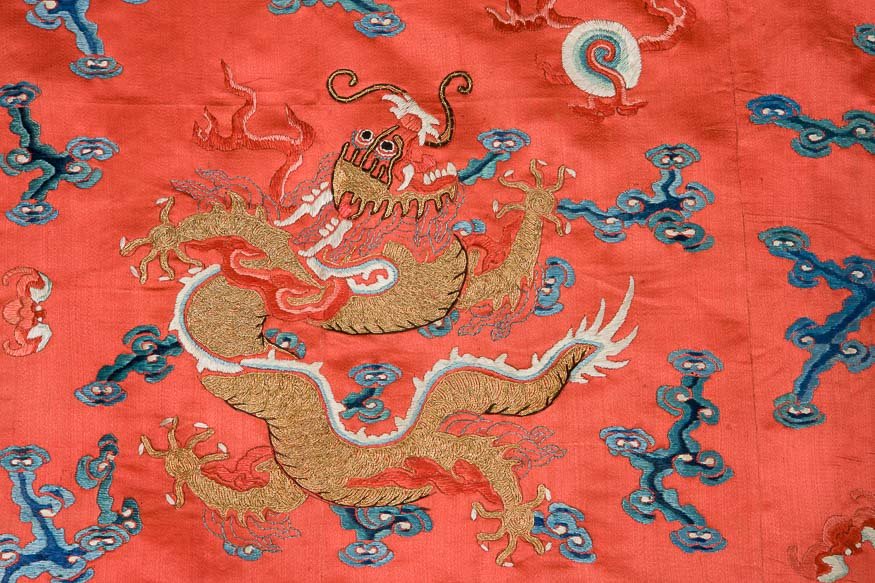
Qing Dynasty, 19th-20th century.
Silk, golden thread, metal mirrors, glass, embroidery.
The front part of the theatre costume features gold couching embroidery depicting a pair of dragons facing each other with a flaming pearl.
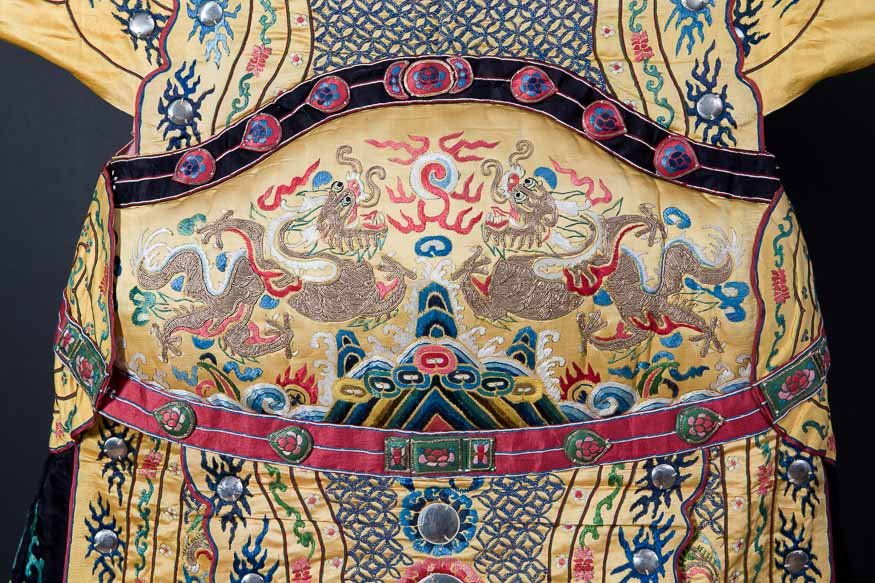
Qing Dynasty, early 20th century.
Silk, golden thread, sequins, embroidery.
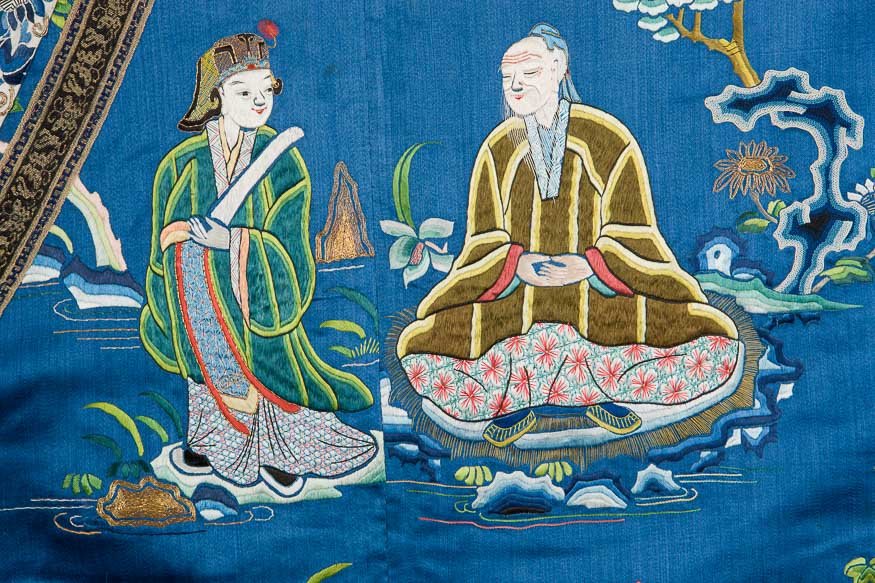
Qing Dynasty, early 20th century.
Silk, golden thread, sequins, embroidery.
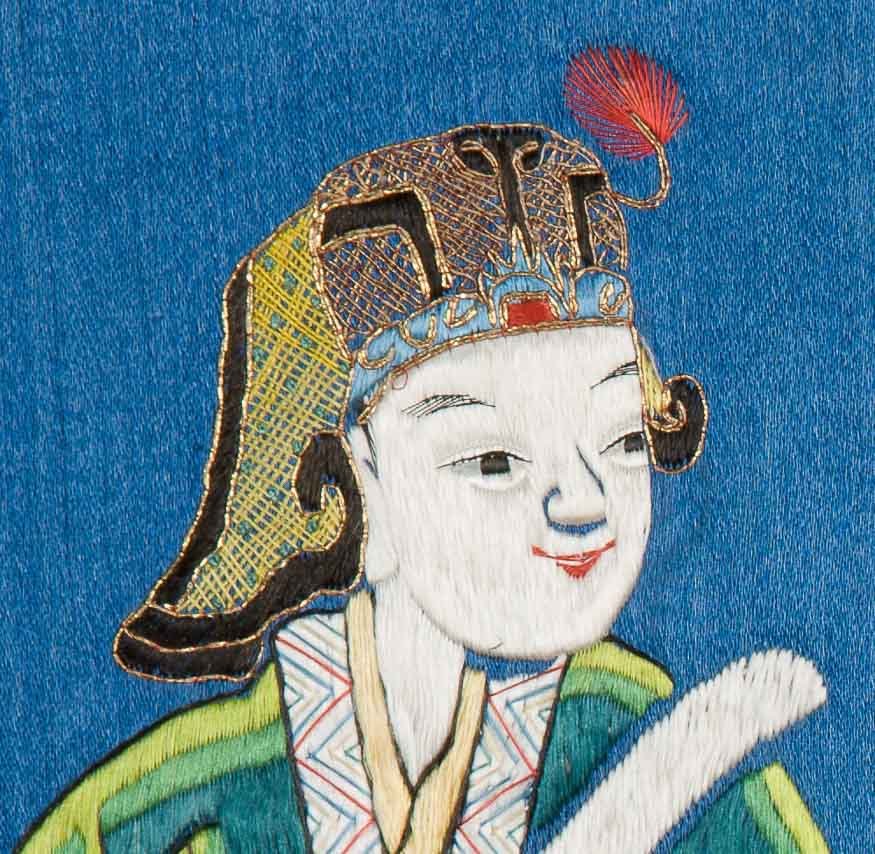
Qing Dynasty, c. mid-19th century.
Silk, cotton, embroidery.
The skirt was decorated with Beijing embroidery. This kind of ornamentation was created using chiefly flat satin stitch. Its distinctive feature is horror vacui – motifs depicting flowers and butterflies fill the whole decorated space.
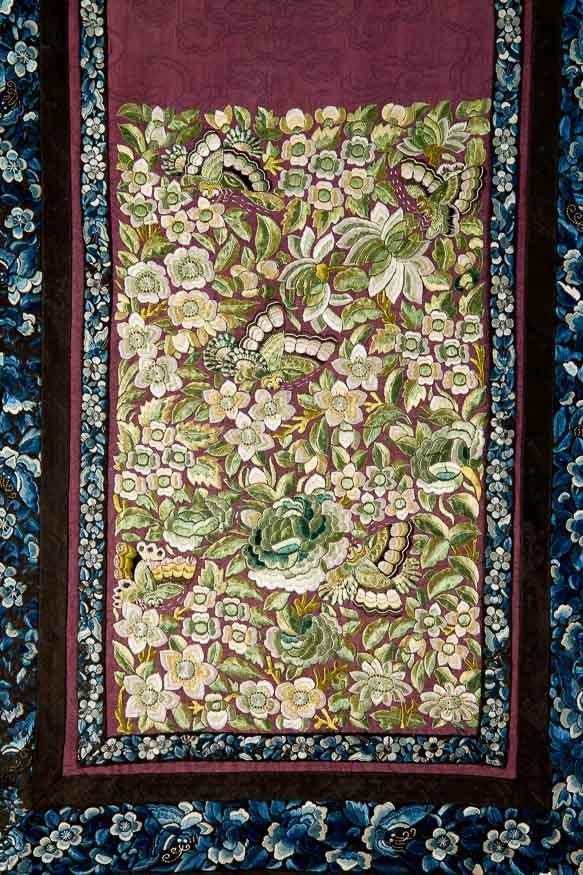
Qing Dynasty, 19th century.
Silk, golden thread, embroidery, applique.
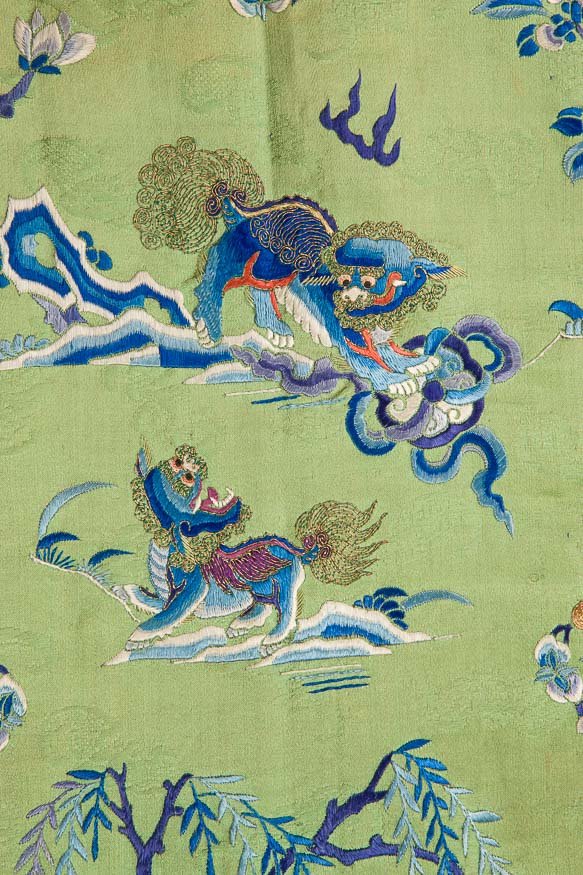
Qing Dynasty, 19th -20th century.
Silk, golden thread, embroidery.
In Chinese culture, a butterfly is a symbol of summer, beauty and dreams. When juxtaposed with a flower, it symbolises marital fidelity.
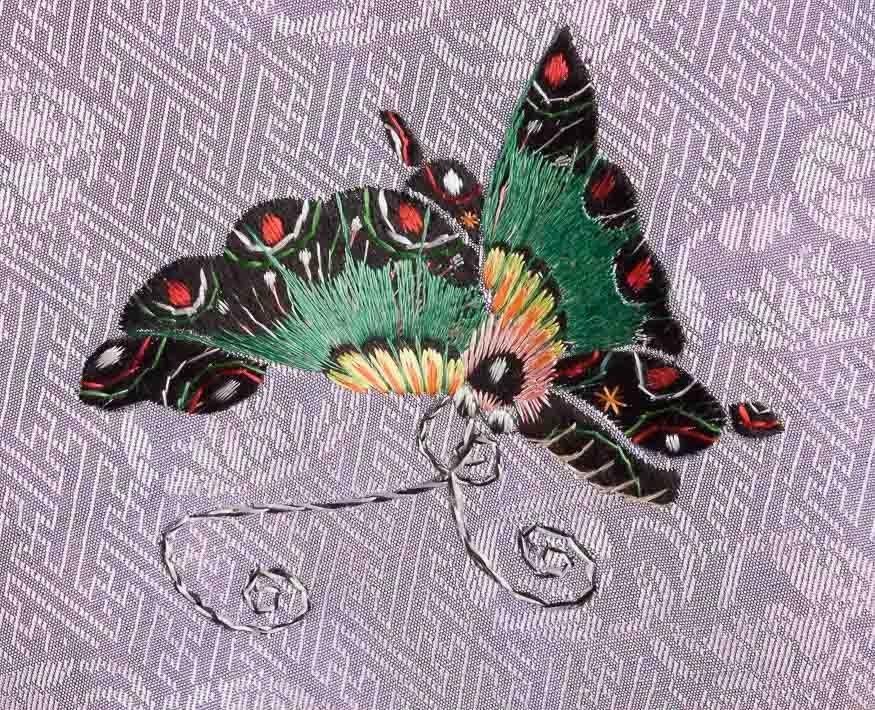
Qing Dynasty, 19th century.
Silk, cotton, golden thread, embroidery, applique.
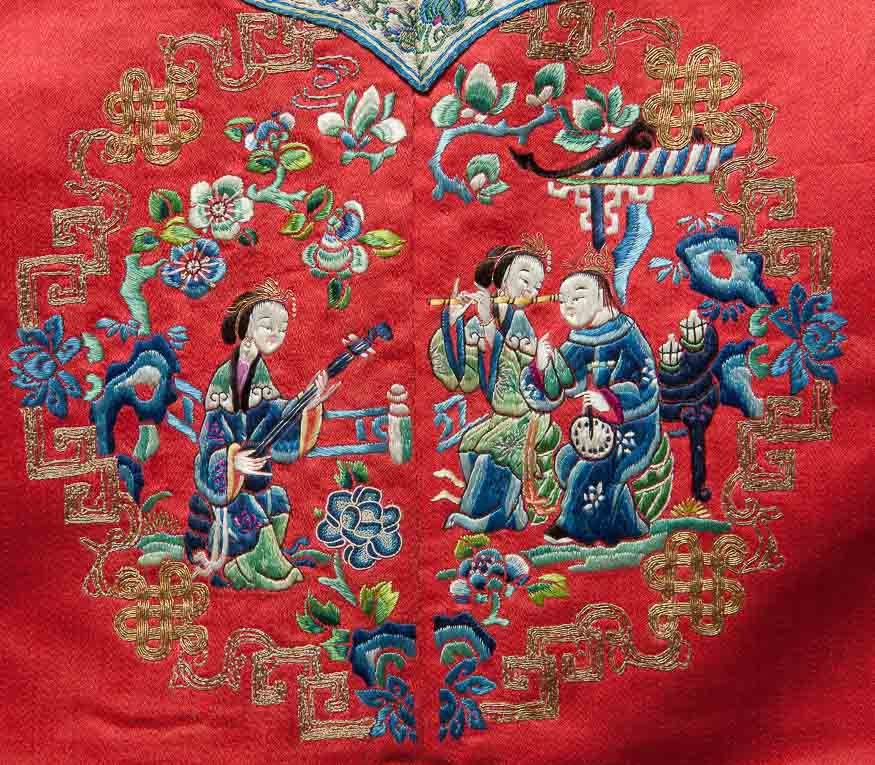
Qing Dynasty, second half of the 19th century.
Silk, golden thread, embroidery.
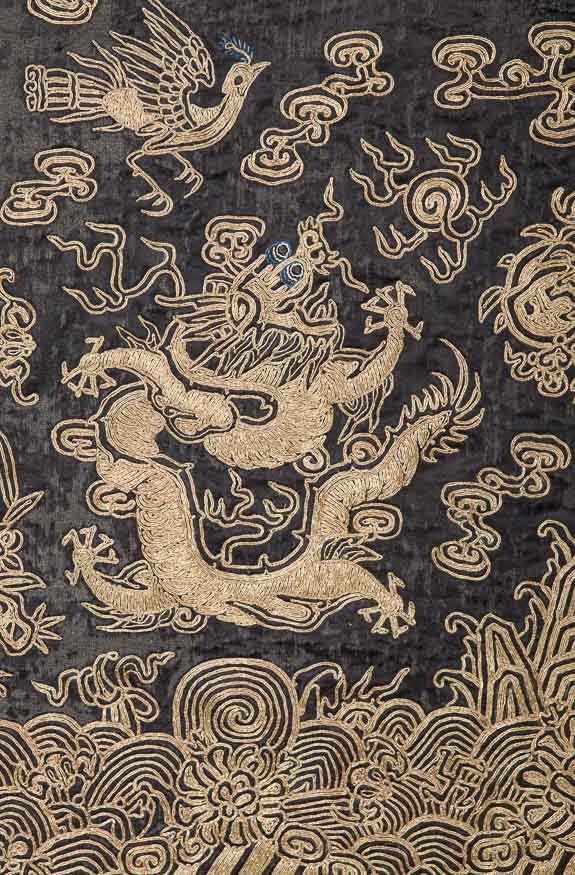


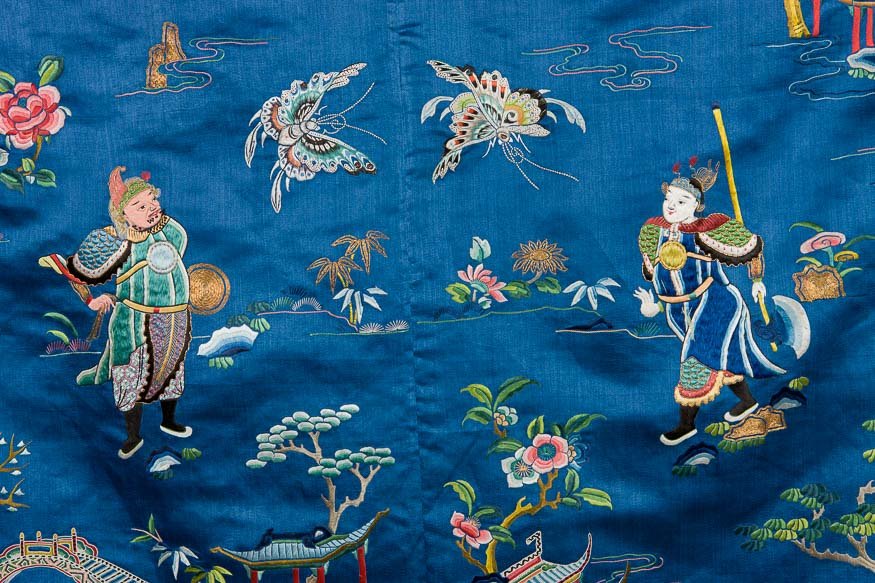
Qing Dynasty, first half of the 19th century, wood, paper, bone, silk, ink, watercolour.
/ photo by Karol Kowalik – Photography Studio, National Museum of Cracow
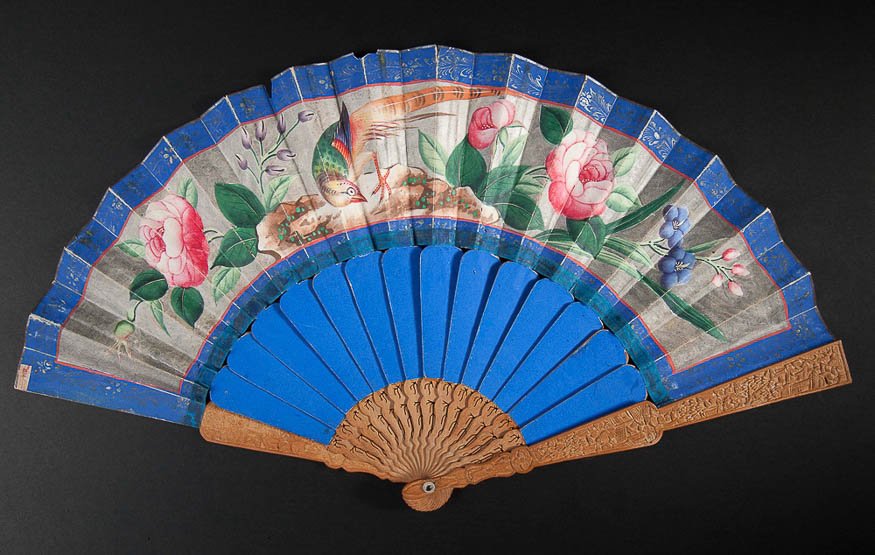
Qing Dynasty, first half of the 19th century, wood, paper, bone, silk, ink, watercolour. / photo by Karol Kowalik – Photography Studio, National Museum of Cracow
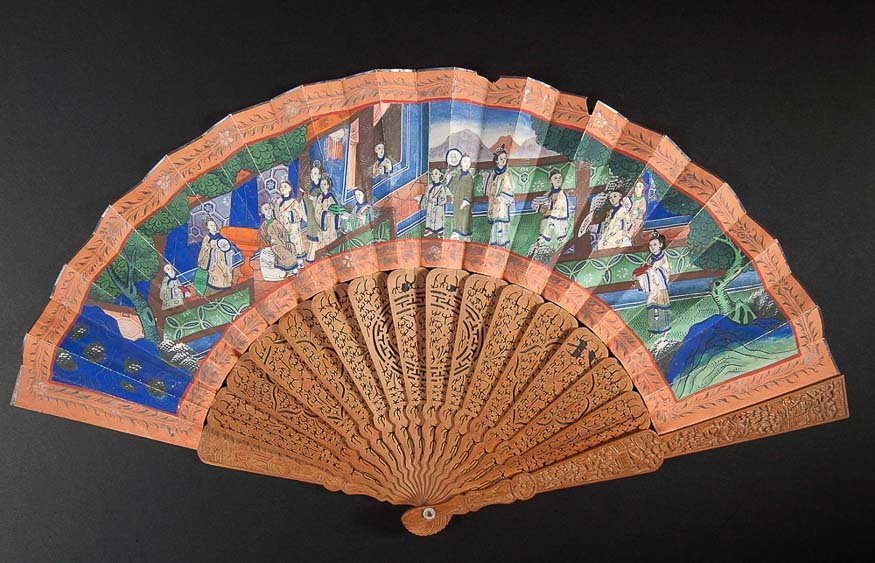
Qing Dynasty, 19th century, silk, watercolour, wood, embroidery. / photo by Karol Kowalik – Photography Studio, National Museum of Cracow
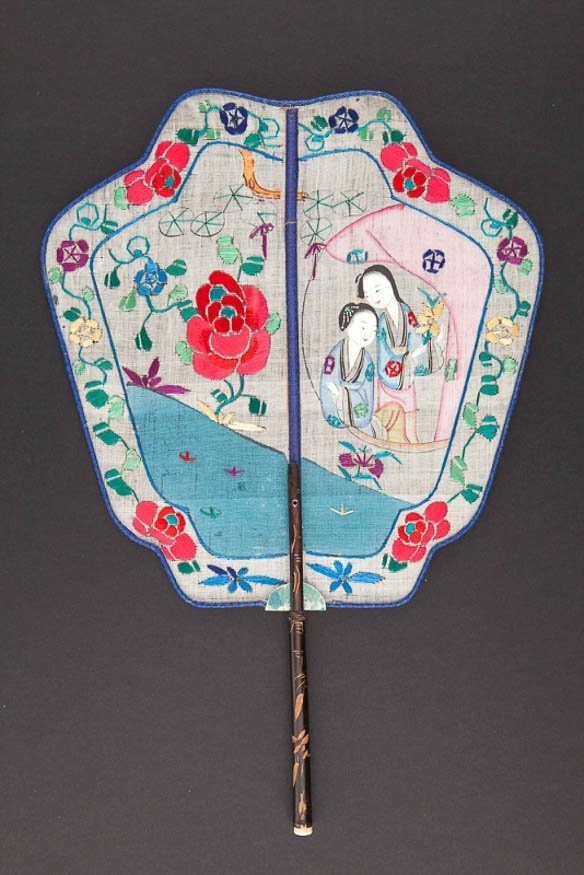
Qing Dynasty, Guangzhou (Canton), 19th century, ivory, carved. / photo by Karol Kowalik – Photography Studio, National Museum of Cracow
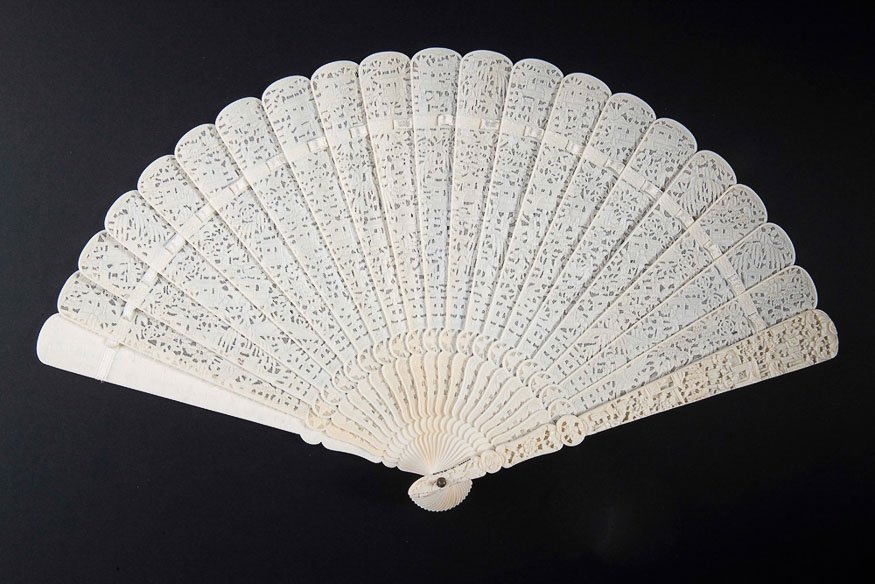
The fan was made in southern, Cantonese style, characterized by masterly development of openwork details. Manufacturers from this region of China were described as „artists weaving with ivory thread”. / photo by Karol Kowalik – Photography Studio, National Museum of Cracow
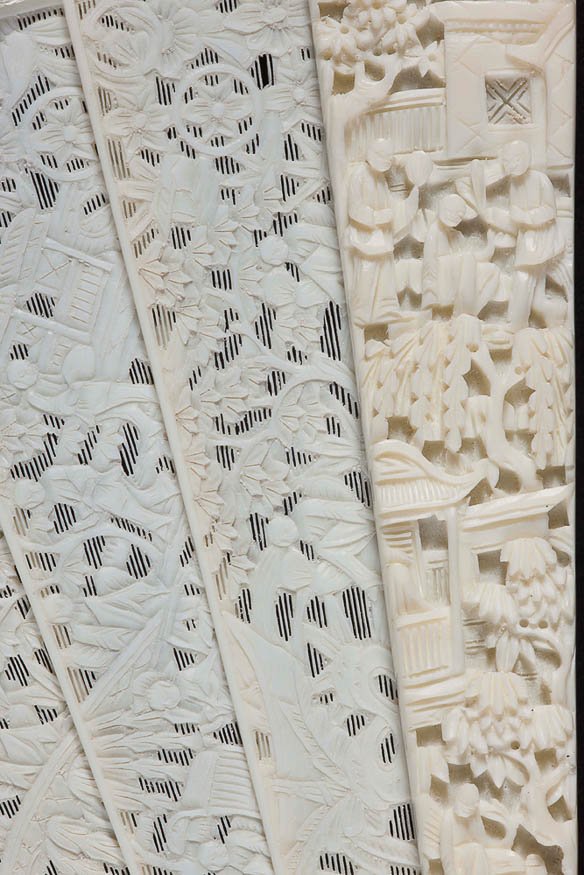
Qing Dynasty, Guangzhou (Canton), c. 1800, wood, lacquer, silk, painted, gilded.
More information about this object can be found in the catalogue published by the National Museum in Krakow. / photo by Karol Kowalik – Photography Studio, National Museum of Cracow
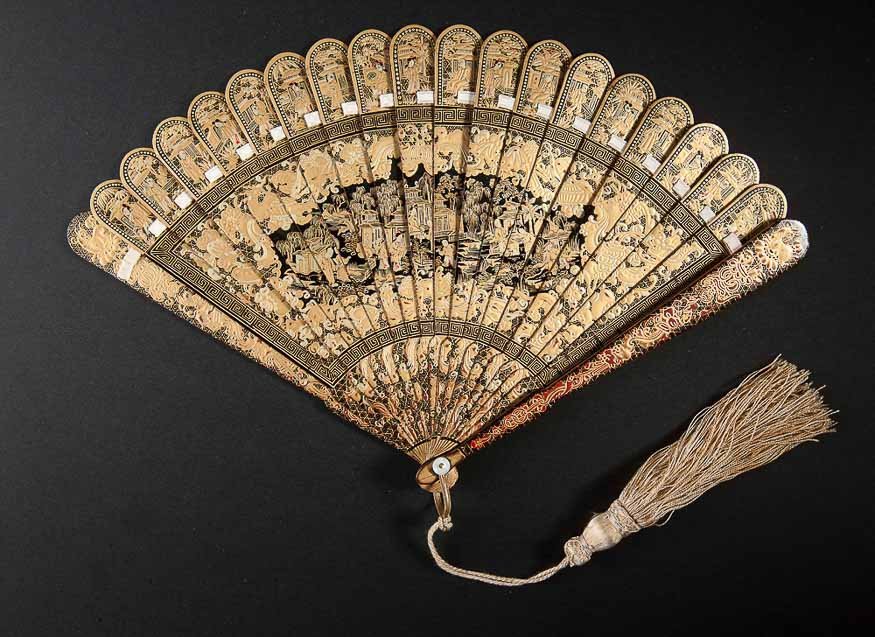
Qing Dynasty, mid-18th century, ebony, silk, paper, watercolour.
The frame of this fan was made of ebony. Guardsticks are carved in an openwork manner with motifs depicting rocks, blossoming plum trees and chrysanthemums. The silk cover is painted with watercolours. The obverse features a composition depicting clumps of orchids and a small bird in flight, while the left side presents a poem written in fourteen columns of characters and two seals. The painted decoration refers to bird-and-flower painting (huaniao hua), which over time - as in the presented fan - inspired arts and crafts. / photo by Karol Kowalik – Photography Studio, National Museum of Cracow
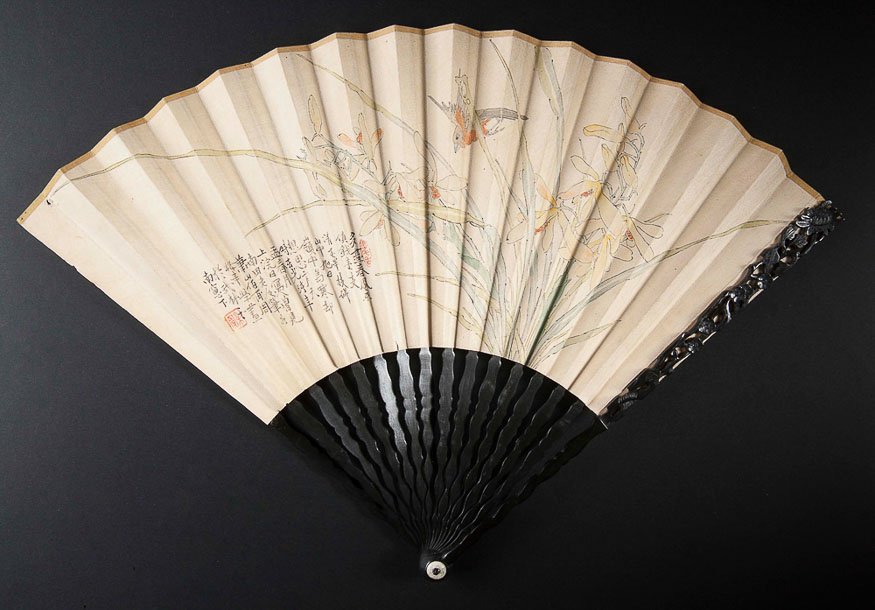
Qing Dynasty, 19th century, silk, watercolour, wood, embroidery. / photo by Karol Kowalik – Photography Studio, National Museum of Cracow
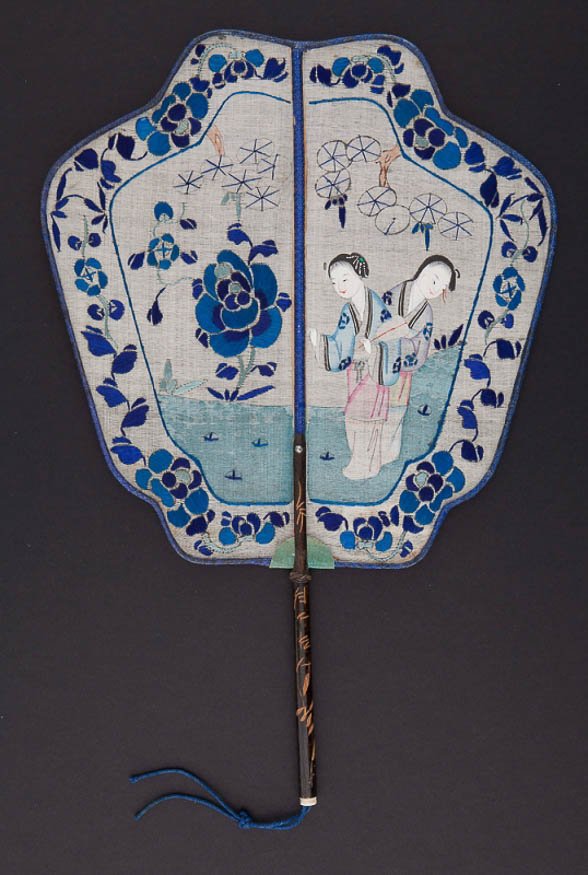
Qing Dynasty, Huzhou, late 19th century, goose feathers, mother of pearl, bone, gouache. / photo by Karol Kowalik – Photography Studio, National Museum of Cracow
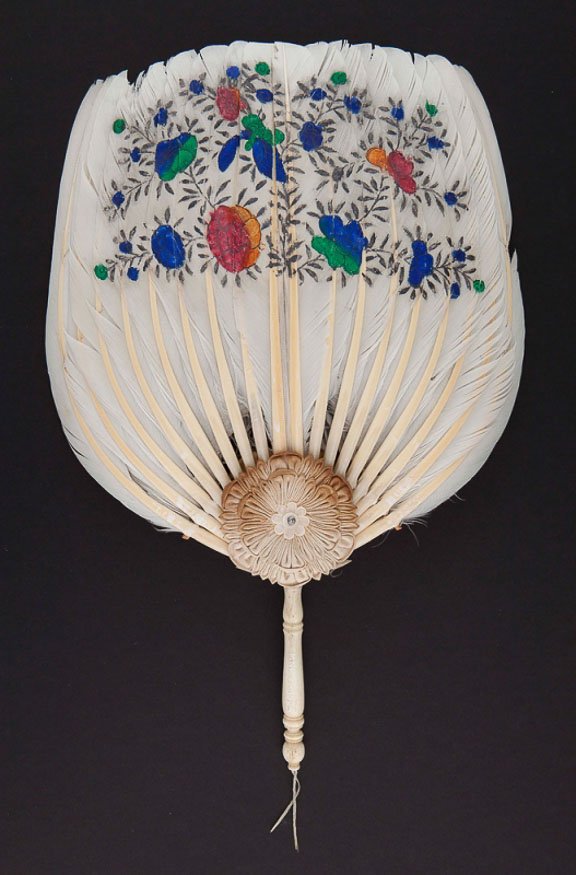
wood, lacquer, silk, paper, bone, carved, painted. / photo by Karol Kowalik – Photography Studio, National Museum of Cracow
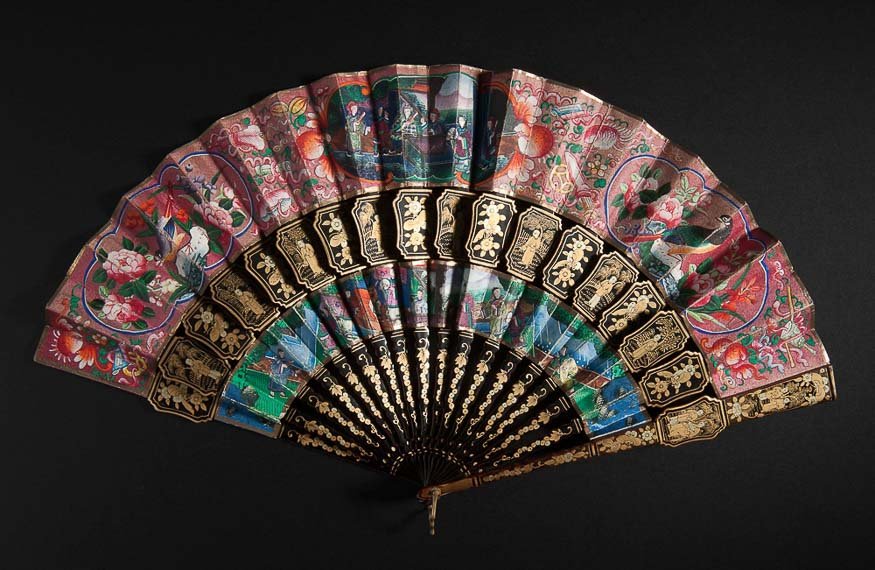
wood, lacquer, silk, paper, bone, carved, painted. / photo by Karol Kowalik – Photography Studio, National Museum of Cracow
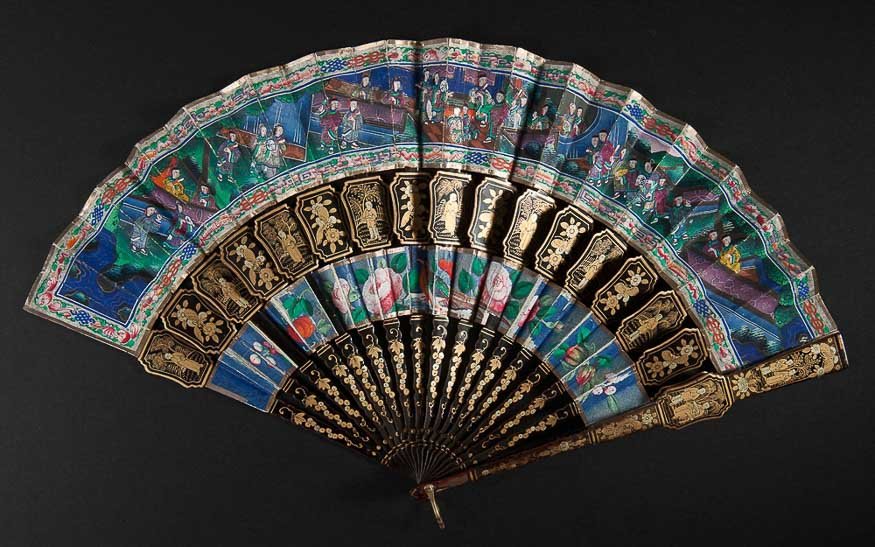
Qing Dynasty, Guangzhou (Canton), mid-19th century.
silk, wood, ivory, carved, painted. / photo by Karol Kowalik – Photography Studio, National Museum of Cracow
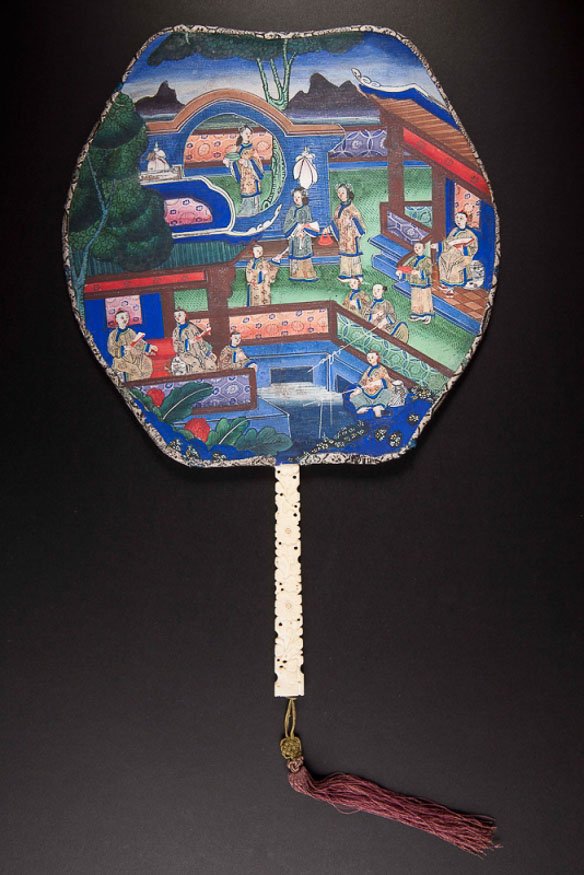
Qing Dynasty, Guangzhou (Canton), mid-19th century.
silk, wood, ivory, carved, painted. / photo by Karol Kowalik – Photography Studio, National Museum of Cracow
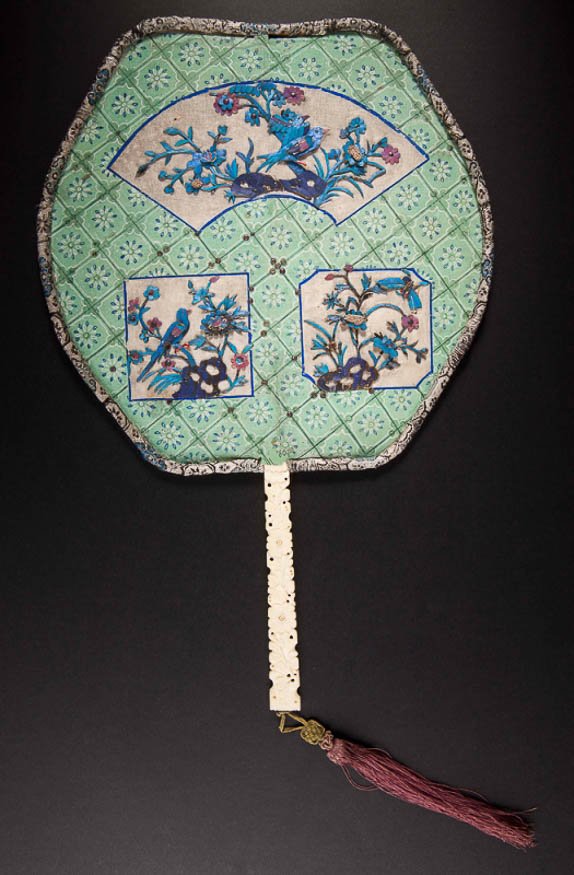
Qing Dynasty, Guangzhou (Canton), second half of the 19th century.
wood, lacquer, paper, silk, bone, carved, painted / photo by Karol Kowalik – Photography Studio, National Museum of Cracow
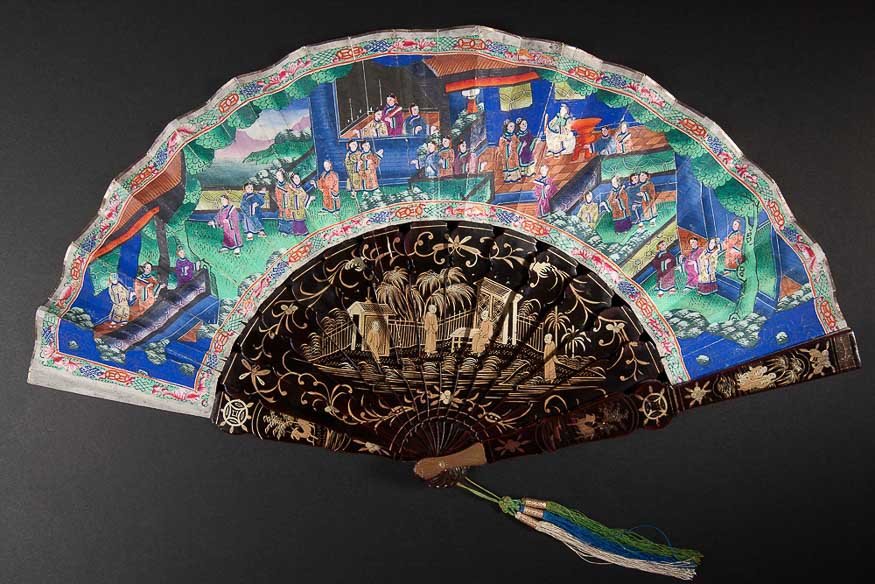
Qing Dynasty, Guangzhou (Canton), second half of the 19th century.
wood, lacquer, paper, silk, bone, carved, painted / photo by Karol Kowalik – Photography Studio, National Museum of Cracow
